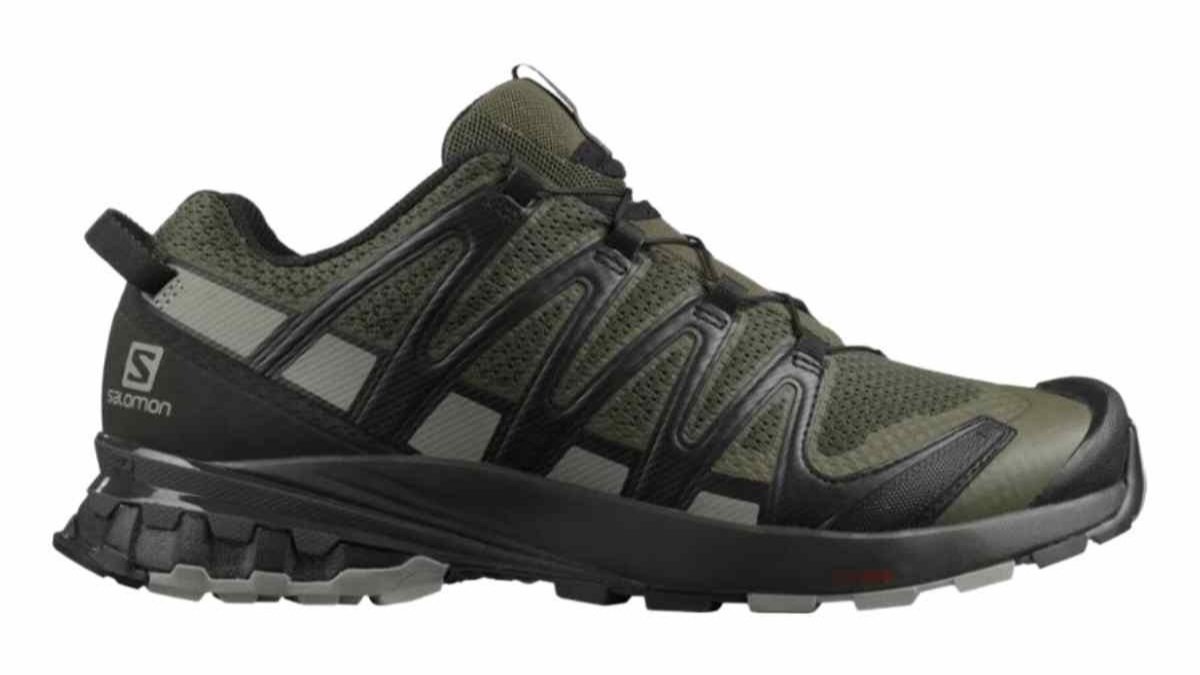Best Men's Trail Running Shoes of 2025
TRAIL RUNNERS FOR RUNNING, HIKING, AND BACKPACKING IN ALL CONDITIONS AND TERRAIN
August 11th, 2025, updated with 10 more shoes including 4 new winners unseating old winners
Home > Gear Reviews > Footwear
Through field testing spanning over 5,000 miles across multiple years and diverse terrain conditions, we've found the best men's trail running shoes – from technical mountain running to ultra-distance thru-hiking. Our extensive testing methodology included trail runs throughout Colorado, New Mexico, and Arizona, including challenging high-altitude environments, plus rigorous evaluation during 2,500+ mile thru-hikes across the Continental Divide Trail and Appalachian Trail.
Our multi-tester approach incorporated direct comparison on identical trail conditions. Our testers ran 25-50 miles per week in rotating shoe combinations. We assessed comfort, durability, traction performance, and long-term stability. We also had testers of different foot shapes and running styles. Testing protocols included back-to-back evaluations on the same trails during identical sessions, wear assessments ranging from quick trail runs to marathon-distance mountain summits, and real-world testing from technical scrambles to loose scree, hardpacked dirt, mud and wet leaves, and slick rock surfaces.
We assessed each trail running shoe for outsole grip across wet and dry conditions, midsole responsiveness and cushioning retention, upper durability and breathability, heel cup stability, and overall comfort during extended use periods.
Our top choice: The La Sportiva Prodigio emerged as our overall best men's trail running shoe because of its combination of responsive cushioning, grippy traction, and all-terrain versatility. It's the best trail running shoe overall for runners seeking maximum performance across any trail condition.
This guide presents our findings on the top-performing men's trail running shoes that delivered superior traction, comfort, and durability across the full spectrum of trail conditions, for serious mountain athletes to new trail runners and hikers.
Looking for gifts for runners in your life? See our Best Gifts for Runners guide
We create reader-supported, objective, independently-selected gear reviews. This story may contain affiliate links, which help fund our website. When you click on the links to purchase gear, we may get a commission, without costing you an extra cent. Thank you for supporting our work and mission of outdoor coverage for every body! Learn more.
Comparison Table
| TRAIL RUNNING SHOE | TREELINE AWARD | MSRP* | SIZES | WIDTHS | DROP | STACK HEIGHT (HEEL TO TOE) | WEIGHT (PER SHOE) |
|---|---|---|---|---|---|---|---|
| La Sportiva Prodigio | Best overall Read why |
$155 | 6 - 16.5 | Standard | 6 mm | 34 - 28 mm | 9.5 oz / 270 g |
| Hoka Speedgoat 6 | Best cushioned Read why |
$155 | 7 - 15 | Standard, wide | 5 mm | 40 - 35 mm | 9.8 oz / 277 g |
| La Sportiva Prodigio Max | Best long distance Read why |
$185 | 40 - 49.5 | Standard | 6 mm | 37 - 31 mm | 10.4 oz / 295 g |
| On Cloudvista 2 | Best minimalist Read why |
$150 | 7 - 14 | Standard | 5 mm | 29 - 24 mm | 10.75 oz / 304 g |
| Merrell MTL Long Sky 2 | Best affordable Read why |
$140 | 7 - 16 | Standard | 4 mm | 23.5 - 19.5 mm | 9.45 oz / 267 g |
| Hoka Challenger 7 | Best crossover road/trail Read why |
$145 | 7 - 15 | Regular, wide | 5 mm | 31 - 26 mm | 8.9 oz / 252 g |
| Altra Timp 5 | Best zero-drop Read why |
$155 | 7 - 15 | Standard | 0 mm | 29 mm | 9.8 oz / 278 g |
| La Sportiva Mutant | Best for traction Read why |
$185 | 40.5 - 47.5 | Standard | 10 mm | 26 -16 mm | 11.2 oz / 317 g |
| Salomon Aero Glide 3 GRVL | Best gravel Read why |
$160 | 9 - 13 | Standard | 8 mm | 40 - 32 mm | 9.7 oz / 275 g |
| La Sportiva Cyklon Cross GTX | Best waterproof Read why |
$245 | 6 - 13.5 | Standard | 8 mm | 28 - 20 mm | 12.5 oz / 355 g |
The Best Men's Trail Running Shoes
Best Trail Running Shoes: La Sportiva Prodigio
Sizes available: 6 - 16.5
Widths available: Standard
Drop: 6 mm
Stack height: 34 - 28 mm
Weight: 9.5 oz / 270 g
What we liked: Responsive midsole, well-cushioned, stable upper, grippy outsole, excels on any terrain
What we didn’t like: La Sportiva sizing is weird
The La Sportiva Prodigio is the most cushioned trail running shoe La Sportiva has ever made. This shoe, which has a 34-28 mm stack height, has become one of our favorite shoes for any condition. It has just the right amount of cushioning for long days on the trail without feeling like it raises your foot’s center of gravity too much, and it’s very light for a shoe with this much cushion.
But unlike some well-cushioned shoes, these are great all-around. For this reason, we’ve given the Prodigio our top choice as the best trail running shoe overall. They feel fantastic while descending, which isn’t what you’d expect from a higher stack height shoe. We’ve worn these on super steep Arizona, Colorado, and Utah mountains. They feel great on the uphill and flat sections and are wildly confidence-inspiring on technical downhill sections of trail, too.
Learn more in our in-depth review of the La Sportiva Prodigio trail running shoes.
La Sportiva Prodigio




-
The midsole, made of La Sportiva’s own XFlow™ foam, is also one of the most responsive we’ve ever worn. The midsole material feels dense yet springy. Initially, it felt so dense that we thought it wouldn’t provide enough cushion, and honestly felt weird. But after wearing these shoes for a run, we were sold. The energy return as you push off is unparalleled. They don’t feel like they have as much cushion as they do, which is a good thing.
-
The outsole rubber is also incredibly sticky. It uses La Sportiva’s Frixion® Red (XT 2.0) outsole. This outsole uses a dual rubber compound with stickier rubber in the center and more durable, longer-lasting rubber on the sides of the sole, where most people tend to wear down their outsoles fastest. This gives you sticky rubber wear you need without sacrificing longevity since stickier rubber is softer and wears down faster.
-
It has a high-tenacity engineered mesh upper that’s very breathable. This upper material barely absorbs any water and makes for one of the fastest-drying shoes we’ve worn. It has a thermoform reinforced toe cap, and this laminating wraps around the sides of the shoe to increase the overall durability across most of the high-wear areas of the upper. The tongue attaches to an elastic nylon mid-foot cage, reinforcing the entire front of your foot.
Many shoes have elasticized material that wraps around the sides of your foot and attaches at the tongue, but these shoes take this approach one step further by attaching the stretch nylon material to the tongue, down around the sides of your foot, and all the way to the toe box. The result is essentially a stretch nylon bootie that wraps around your entire forefoot for a super secure and stable fit.
-
La Sportiva recently released a Prodigio Pro version of the beloved Prodigio featuring super critical EVA foam midsole commonly used in "super shoes." The Prodigio Pro is a huge improvement over the standard Prodigio. If the Pro didn’t cost $195, we would recommend it over the standard Prodigio. You can read more in our review of the Prodigio Pro below. However, we just can’t bring ourselves to recommend a shoe that costs that much more for everyone. If you have an extra 40 bucks, the Prodigio Pro is a stellar shoe, but the standard Prodigio is also great. You can’t go wrong with either choice.
-
If you’ve never worn La Sportiva shoes, the sizing is a bit weird. We wear a full size larger in La Sportiva than we do with other trail running shoes. Many people find La Sportiva shoes are too narrow as well. But once we figured out we needed to size up, we found they weren’t too narrow anymore.
-
These have a toe box that is wide enough for Sam, our main tester, and he has slightly wider than-average feet. If you need an extremely wide shoe, we recommend the Topo Athletic Ultraventure 3, Hoka Speedgoat 6 (which comes in wide sizes), or either of the Altra models we tested here—the Timp 5 and Lone Peak 8. However, we've seen many people who fit into the Prodigio, so they’ll probably fit your feet, too. Just remember to size up a full size.
-
There aren’t many shoes that offer this much cushion in such a responsive, stable, and grippy platform, and for that reason, we think the Prodigios are the best trail running shoes overall.
Best cushioned trail running shoes: Hoka Speedgoat 6
Sizes available: 7 - 15
Widths available: Standard, wide
Drop: 5 mm
Stack height: 40 - 35 mm
Weight: 9.8 oz / 277 g
What we liked: Lightweight, great for mixed surface runs, well-cushioned
What we didn’t like: Not the best on rough terrain
The Hoka Speedgoat 6 is the most cushioned trail runner we tested and one of our favorites for ultra-distance running and fast hiking. We’ve been wearing Speedgoats for years, and we love the generous amount of cushioning, the sticky Vibram Megagrip outsole, and the very supportive upper.
The Hoka Speedgoat 6 are our overall winner in our Best Women's Trail Running Shoes guide.
You can read our in-depth review of the Hoka Speedgoat 6 for more details.
Hoka Speedgoat 6





-
We wore the Speedgoats while thru-hiking the Continental Divide Trail, where we hiked an average of about 50K daily. We’ve also put a ton of trail running miles on these shoes in Colorado, New Mexico, Utah, and Arizona. Most recently, we thru-hiked the 160-mile Collegiate Peaks Loop in Colorado wearing the newest Speedgoat model, the Speedgoat 6.
-
The newest version of Speedgoat has an extra millimeter of heel-to-toe drop. The stack is now 38-33 mm, whereas the Speedgoat 5 was 38-34 mm. This change isn’t noticeable, and overall, the Speedgoat 6 feels pretty much identical to the Speedgoat 5.
The Speedgoat 6 is also lighter than the previous version, weighing 9.8 oz per shoe, compared to the Speedgoat 5, which weighed 10.3 oz per shoe. The Speedgoat 6 has a new breathable woven textile upper, a lighter midsole that’s also more responsive, and a dual-gusset tongue that’s exceptionally comfortable. You can read more about the Speedgoat 5 in our in-depth review.
-
As mentioned above, the Speedgoats have 33 millimeters of stack height. This cushion is the most of any trail runner we tested. This feature leads to a diminished trail feel but allows you to walk over sharp rocks without feeling them on the bottom of your feet.
-
The Speedgoat 6 also has a sticky Vibram Megarip outsole with deep enough lugs to grip dirt and mud. These shoes grip everything between the sticky rubber and the large v-shaped lugs.
-
They also have an extremely stable upper. When you lace these shoes, the mesh wraps around your foot as if it were designed for your foot. This upper is one of the best-fitting ones we’ve worn, and it stays comfortable all day.
-
The Hoka Speedgoat 6 shoes have a ton of stack and cushioning and you can feel it, especially on bigger mile days. In theory, more stack means a higher center of gravity for your feet and ankles. So, in theory, the Speedgoats should be more prone to causing a rolled ankle than shoes with a low stack height. However, in all the years and miles we’ve put into these shoes, we haven’t ever rolled an ankle. That’s more than we can say about other trail runners with much less stack height.
Best for long distances: La Sportiva Prodigio Max
Sizes available: 40 - 49.5
Widths available: Standard
Drop: 6 mm
Stack height: 37 - 31 mm
Weight: 10.4 oz / 295 g
What we liked: cushioning, durability, firmer midsole that lasts longer, comfort
What we didn’t like: price
The La Sportiva Prodigio Max is our new favorite shoe for long distances because it has tons of cushioning, a durable upper, and a super solid midsole that doesn’t compress as quickly as many high-stack trail running competitors.
We love the HOKA Speedgoat’s pillowy-soft cushion, but its midsole foam compresses after about 300 miles. The Prodigio Max, on the other hand, has a firmer midsole that lasts longer. So while they don’t feel quite as soft as the Speedgoats initially, they feel more comfortable for more miles.
We wore the Prodigio Max while thru-hiking 500 miles on the New Mexico section of the Continental Divide Trail. Before we left, we wore them trail running in Arizona. We weren’t planning to wear them on the CDT, but after a few runs, we were sold. The toe box is wide enough for our tester’s wider-than-average feet, the midsole feels solid and lasts a long time, and the upper mesh is reinforced with TPU-wire overlays, so the shoes won’t fall apart if you tear the upper.
Read our full, in-depth review of the La Sportiva Prodigio Max here.
La Sportiva Prodigio Max
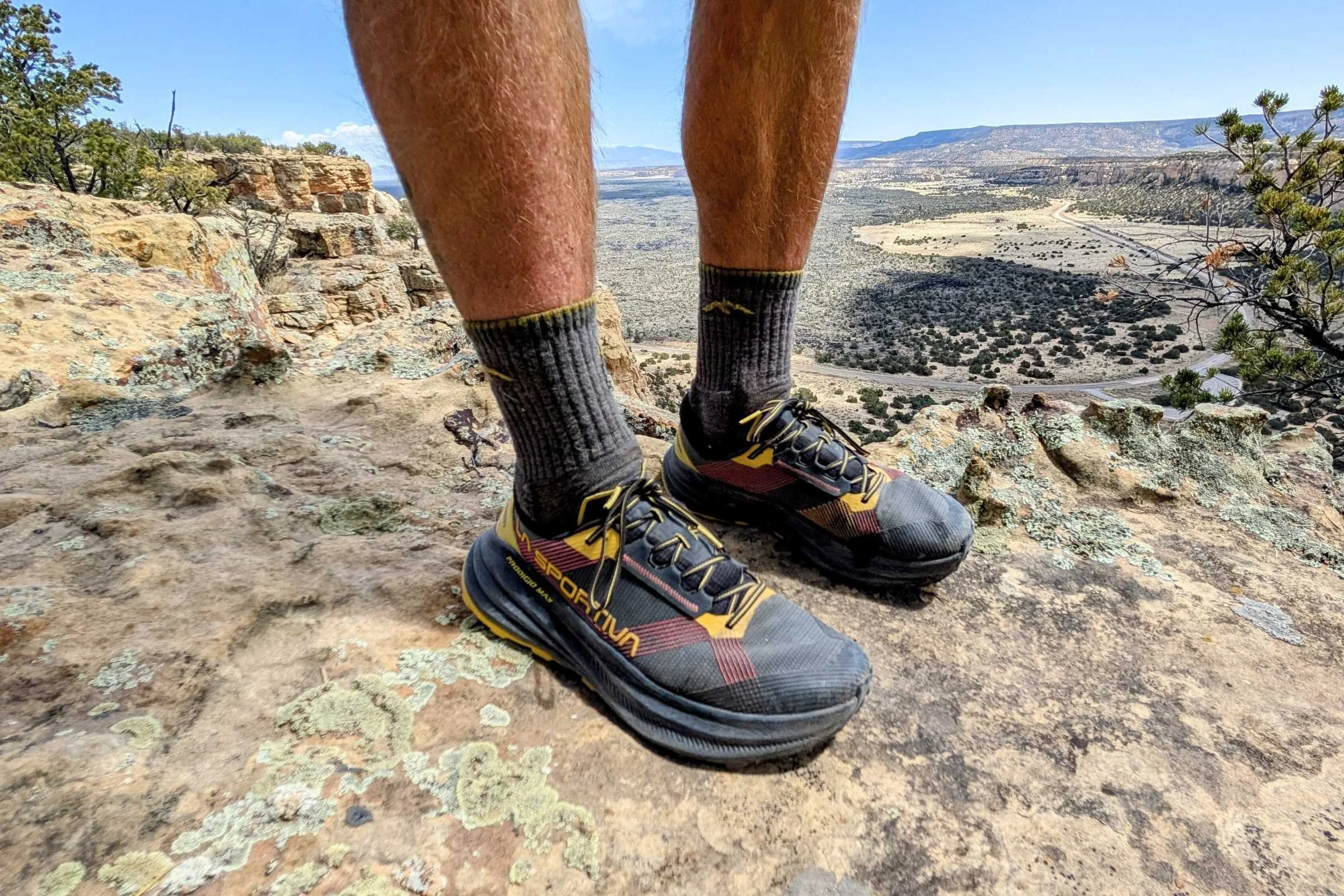
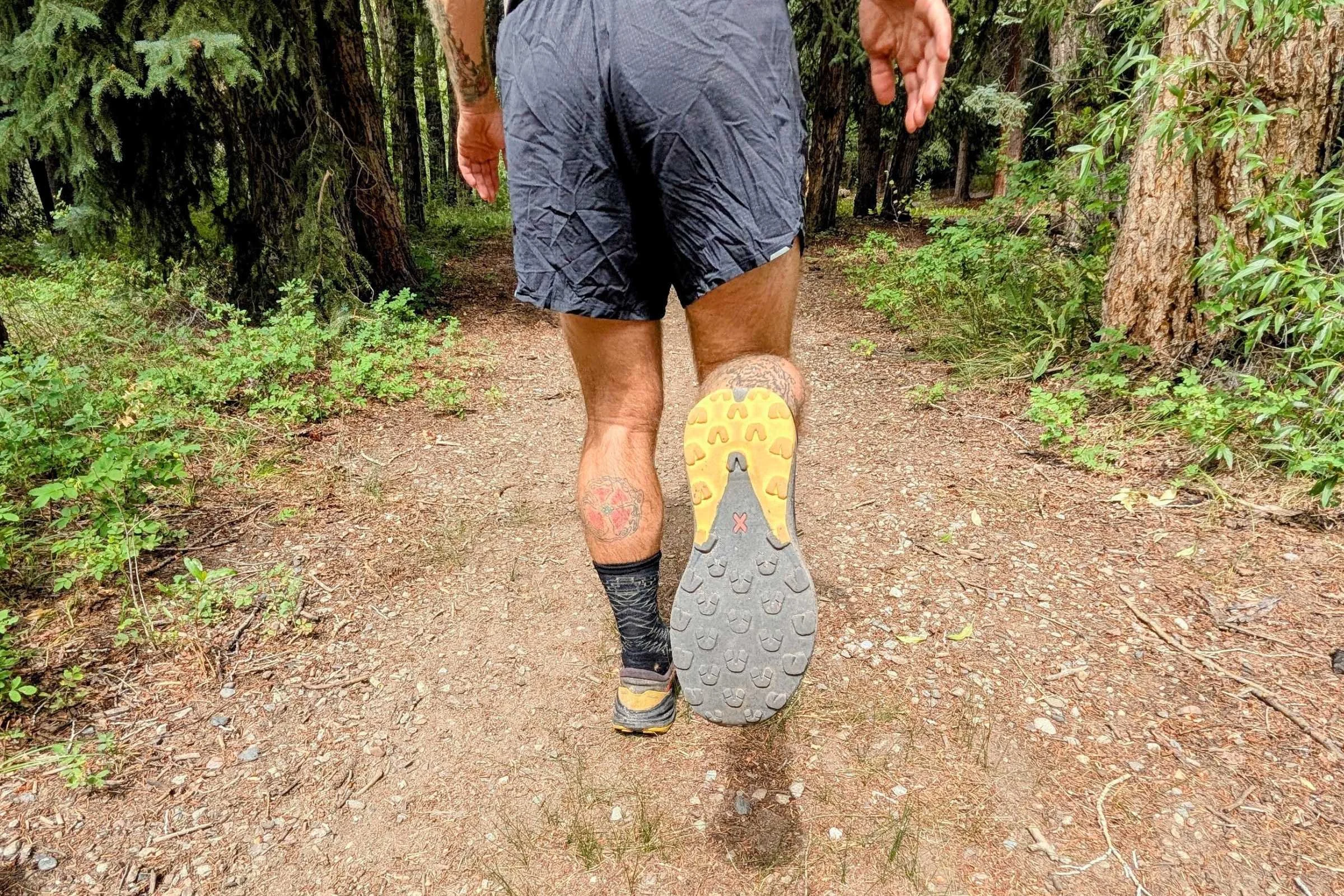
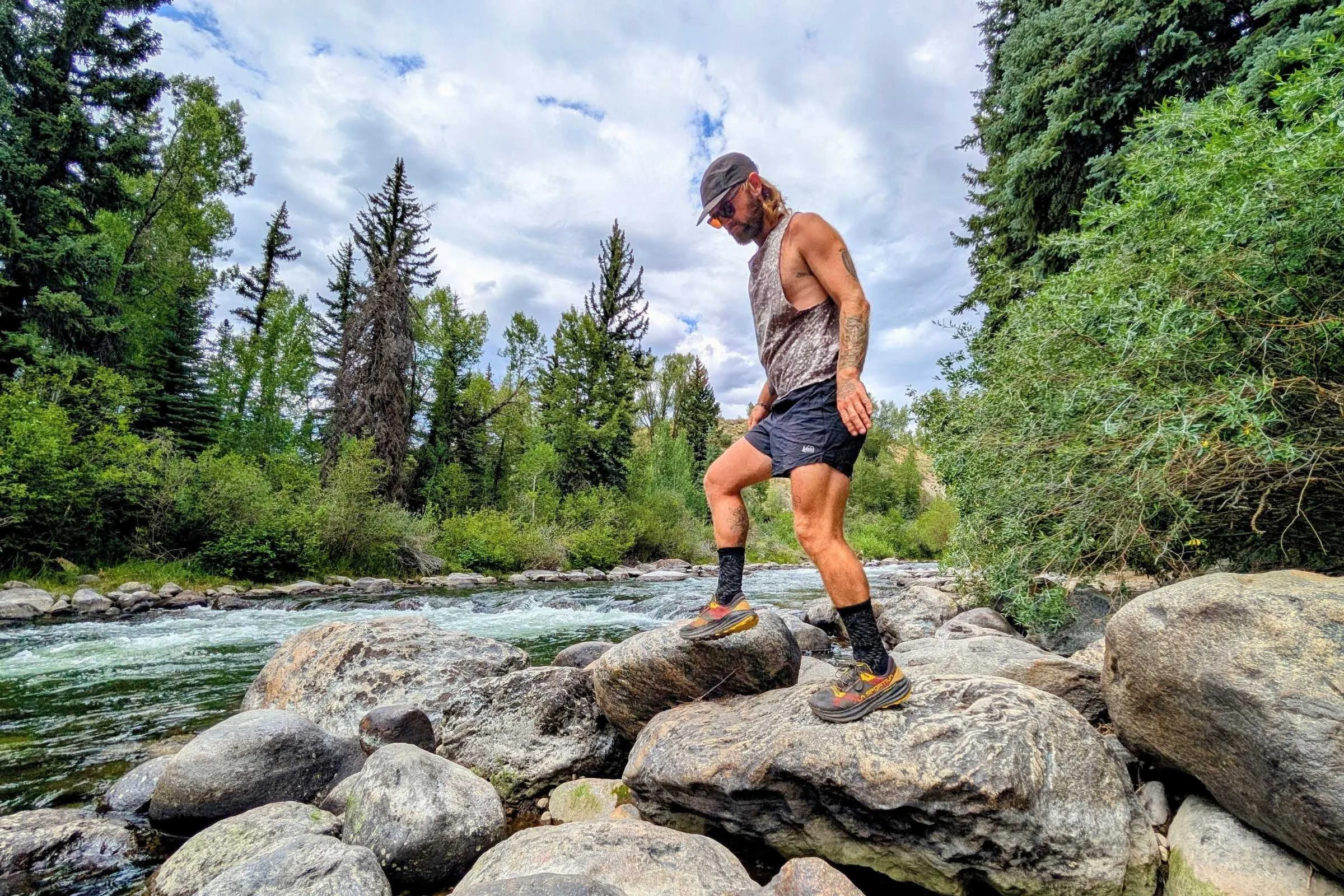
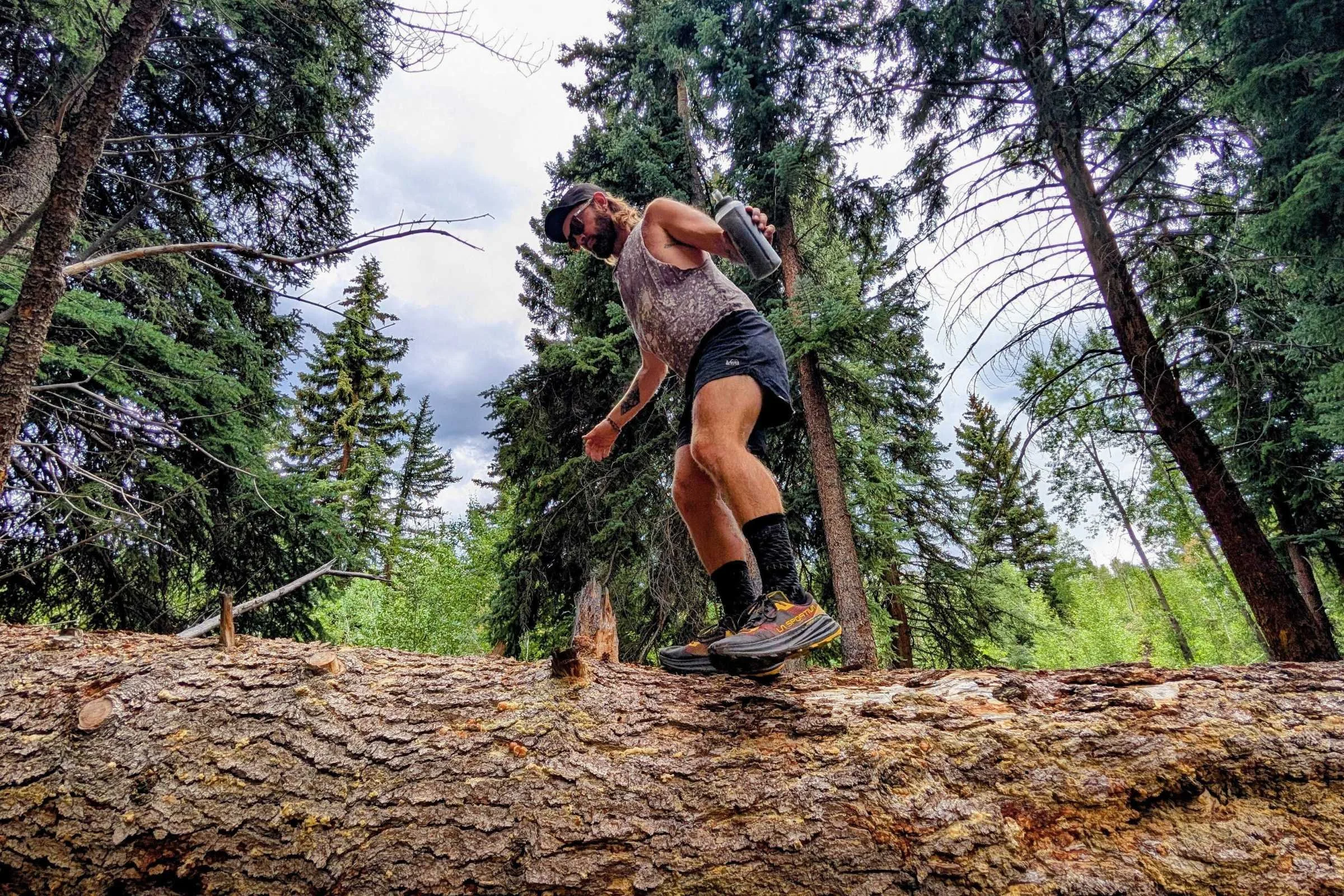
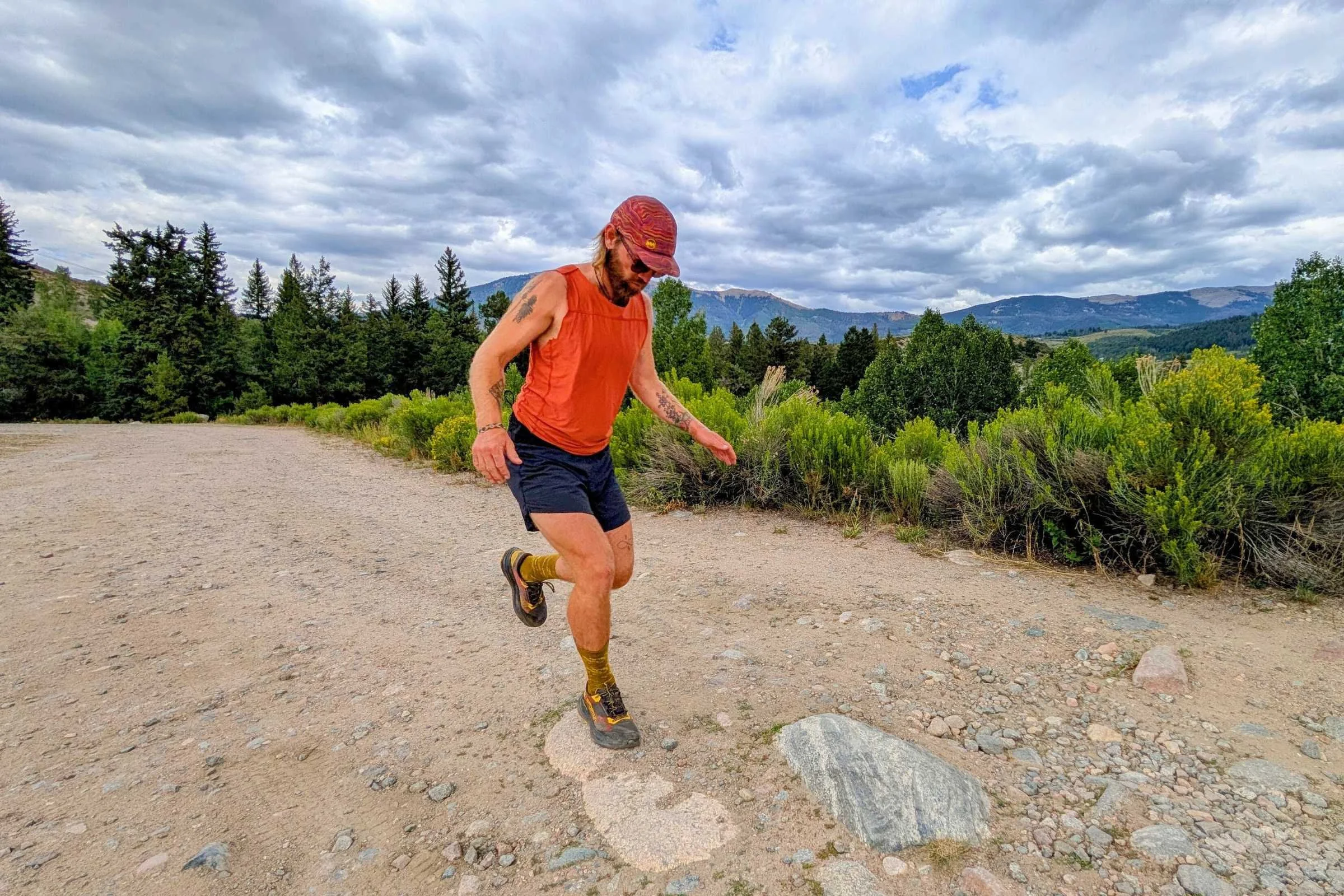
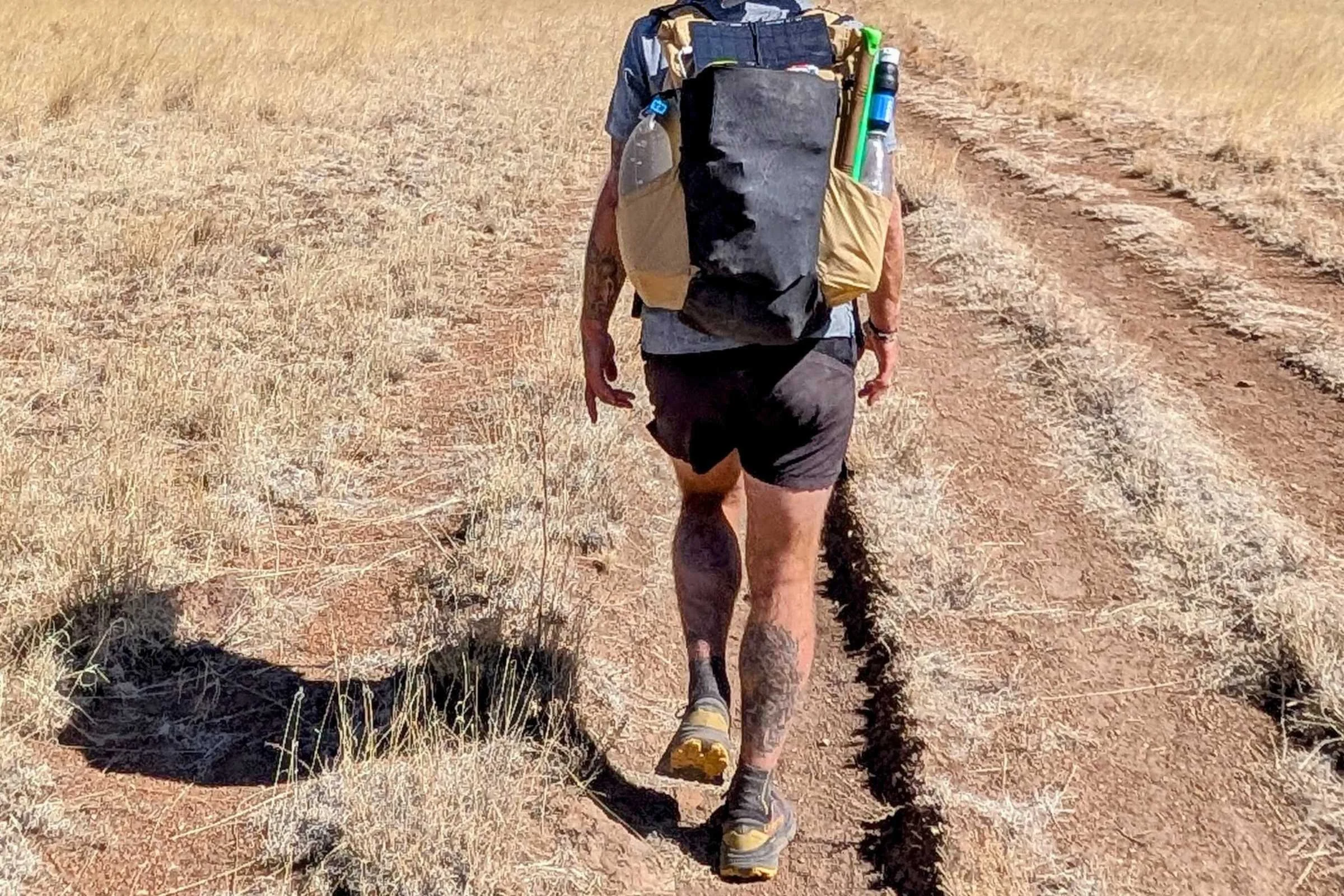
-
After over 500 miles, our Prodigio Max trail running shoes don’t look brand new anymore, but they still have a lot of life left in them. The midsole is made with La Sportiva’s XFlow Endurance with EVA+NITRO along the outside, with an eTPU inner core. The result is more longevity around the outside with more cushion in the middle to help absorb impact underfoot.
-
They have 37mm of stack in the heel and 31mm in the forefoot. This is enough cushion for any long-distance endeavor. We wouldn’t want any more cushion underfoot than this because it would negatively affect the stability. The HOKA Speedgoat 6, for reference, has 40-35 mm of stack in the men’s shoe and 38-33 mm of stack in the women’s.
-
The upper mesh is very durable and supportive. The TPEE (thermoplastic polyester elastomer) mesh upper is very durable on its own, but it also has TPU yarn overlaid across the mesh, which increases its durability. The TPU yarn, which is anchored to the mesh fabric with ultra-resistant nylon, also adds more stability, since it connects from the laces to the midsole. This design prevents the upper mesh from stretching as you move. After over 500 miles, there are some tears in the mesh upper of our pair, but that’s common with trail running shoes. However, the small tears in the mesh are underneath the TPU wire overlays, so those tears won’t result in catastrophic failure anytime soon.
-
The Prodigio Max also has a grippy outsole that provides excellent traction on anything from wet and loose terrain to hard-packed dirt. The outsole material is a bi-compound rubber, with more durability around the edges and more grip in the center. They have 4mm U-shaped lugs oriented for grip when pushing off in the front and for braking in the heel. This FriXion XT 2.0 rubber compound isn’t the most grippy of La Sportiva’s outsole compounds, but it’s still stickier than the rubber used in most other trail running shoes.
-
The biggest drawback of the La Sportiva Prodigio Max is the price. They cost about $30 more than the HOKA Speedgoat 6. While the Max has a more durable midsole and upper than the Speedgoat, that’s still a lot more for a pair of trail running shoes. The Max will probably last at least 20 percent longer than the Speedgoat, especially if you retire your Speedgoats when the midsole flares out like a pancake after 300–350 miles (unlike us, despite what every PT we’ve ever spoken with says). So while they are more expensive, you’ll pay fewer dollars per mile than you would with the Speedgoats.
-
Like every La Sportiva shoe we’ve worn, we get a full size larger than we usually wear in other brands with the Prodigio Max. We recommend you do the same.
-
For a stellar all-around trail running shoe that is stable and comfortable for long days on the trail, you can’t do much better than the Prodigio Max.
Best minimalist trail running shoes: On Cloudvista 2
Sizes available: 7-14
Widths available: Standard
Drop: 5 mm
Stack height: 29 - 24 mm
Weight: 10.75 oz / 304 g 9.9 oz / 280 g
What we liked: Lightweight, responsive midsoles, nimble, speedy
What we didn’t like: Tread doesn’t provide the most traction
The On Cloudvista 2 are some of the simplest and lightest trail runners we tested. When we first held these shoes, we thought, “This is a trail runner?!” They don't look very different from a road shoe, but we were shocked at how well they performed on the trail. We had only planned a quick four- or five-mile run to start, but after 5 miles, they felt too good to turn around – so we doubled the distance.
They have a confidence-inspiring upper that comfortably wraps around your foot. And the lightweight, minimalist feel makes hills feel almost effortless.
See our in-depth review of the On Cloudvista 2 trail running shoes here.
On Cloudvista 2



-
The Cloudvistas 2 feature the same lightweight midsole design as other On shoes, like the On Cloudeclipse, On Cloudsurfer, and the On Cloudmonster.
The Helion foam sole is at the heart of this design, with hollow sections that let you see through the midsole. This unique sole uses a patented combination of stiff and soft materials, resulting in a lightweight and snappy feel unique to On shoes.
-
The newest version has a shorter stack height (now a heel of 29 mm; toe 24 mm). The drop changed from 5 mm vs. the 9 mm in the previous version. As a result, it weighs almost an ounce less per shoe (9.9 oz vs 10.75 oz in the previous version).
-
The design was initially intended for road running, but On added small rubber lugs to the outsole for the Cloudvista. They also beefed up the upper with durable mesh and a reinforced toe cap. They also have a thin integrated tongue that makes for a highly comfortable shoe.
-
Though we loved how these shoes feel on hardpacked dirt, the minimal lugs don’t provide the best traction on loose terrain. The tread looks like it could almost be a road shoe, and we think they’re great for those runs that involve gravel, hardpacked dirt, and even some pavement. But they're not the best for traction in mud, snow, or steep and loose dirt.
-
However, we love how these lightweight, minimalist shoes feel on maintained trails and hardpacked dirt. On those runs with a little bit of everything, the Cloudvistas offer an excellent balance of weight and comfort with just enough protection.
Best Affordable Trail Running Shoes: Merrell MTL Long Sky 2
Sizes available: 7-16
Widths available: Standard
Drop: 4 mm
Stack height: Heel 23.5 mm; toe 19.5 mm
Weight: 9.45 oz / 267 g
What we liked: Very stable, comfortable, Vibram MegaGrip outsole
What we didn’t like: Not the most cushion
The Merrell MTL Long Sky 2 are some of Merrell’s top-of-the-line trail running shoes, yet they cost less than most other models we tested. With the Long Sky 2s, you get a fully loaded shoe for an entry-level price, making it a stellar value. These shoes also seem to be on sale frequently, and when they’re discounted, they’re an even better deal.
These are some of our favorite trail running shoes for scrambly mountain runs. We have logged tons of miles in these shoes on everything from high routes in Colorado’s San Juan Mountains to the Maroon Bells Four Pass Loops and a 50k race in Moab, Utah. They’re fast and grippy. They’re light, quick, and responsive. And they inspire confidence underfoot, no matter where you take them.
Merrell MTL Long Sky 2
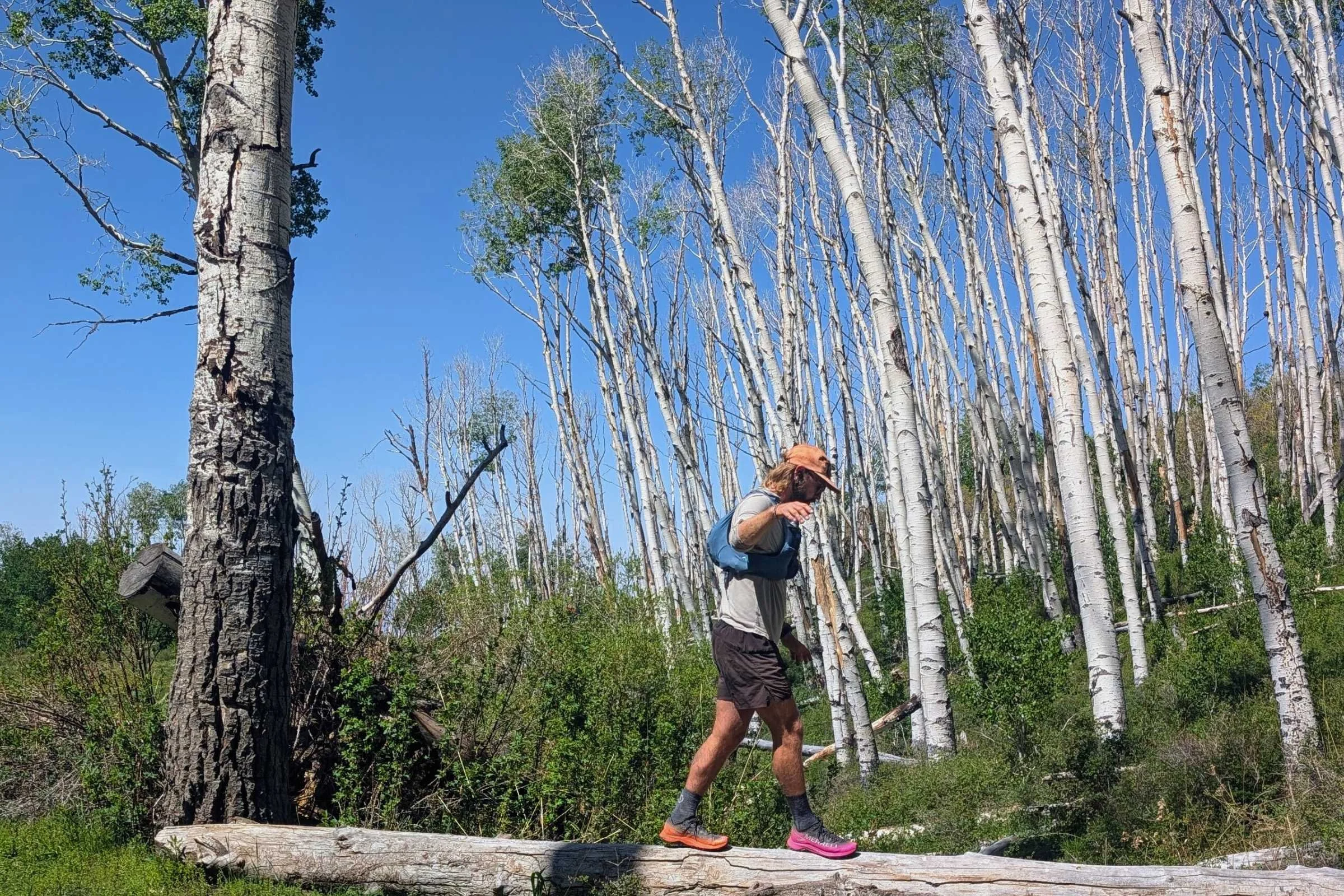
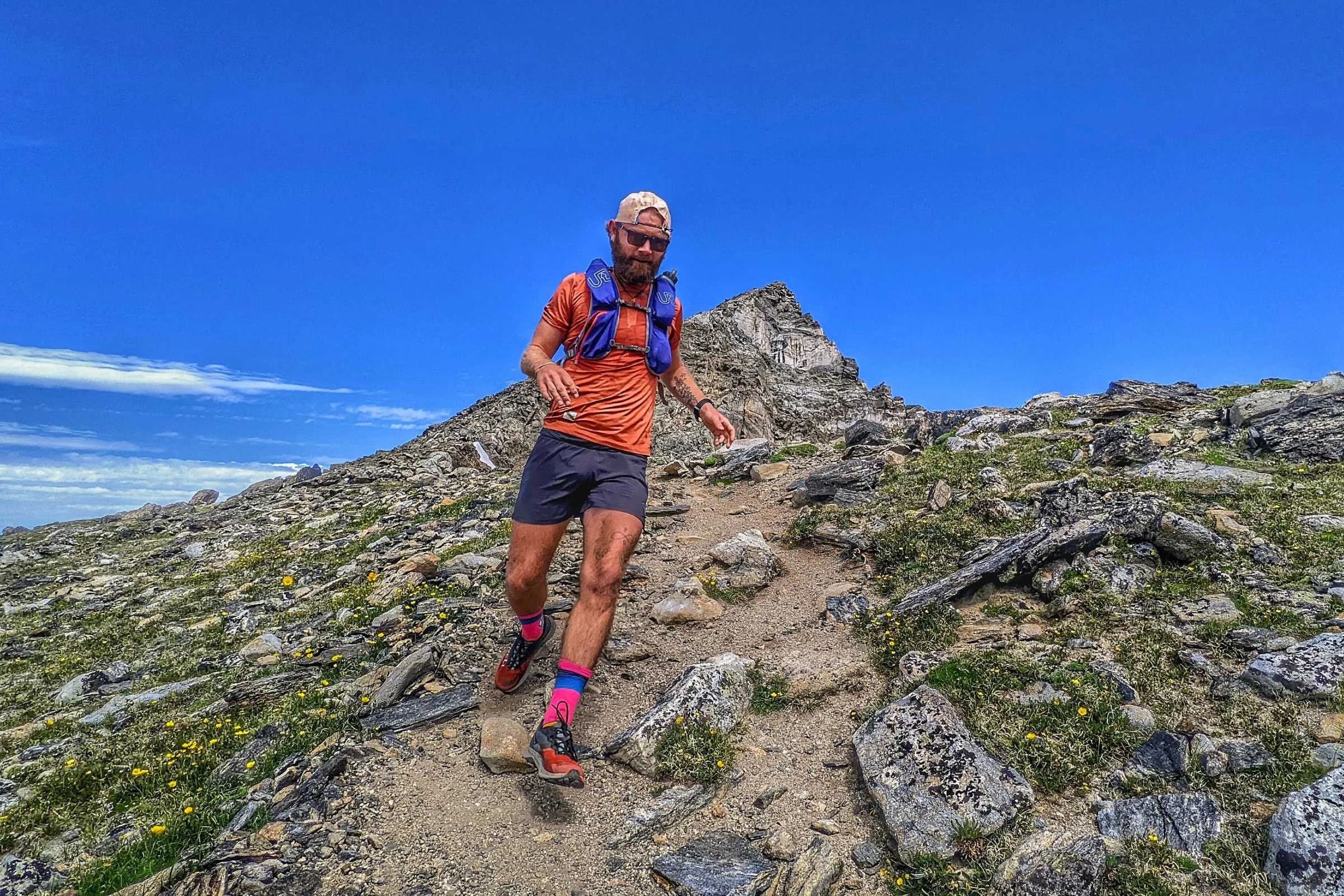
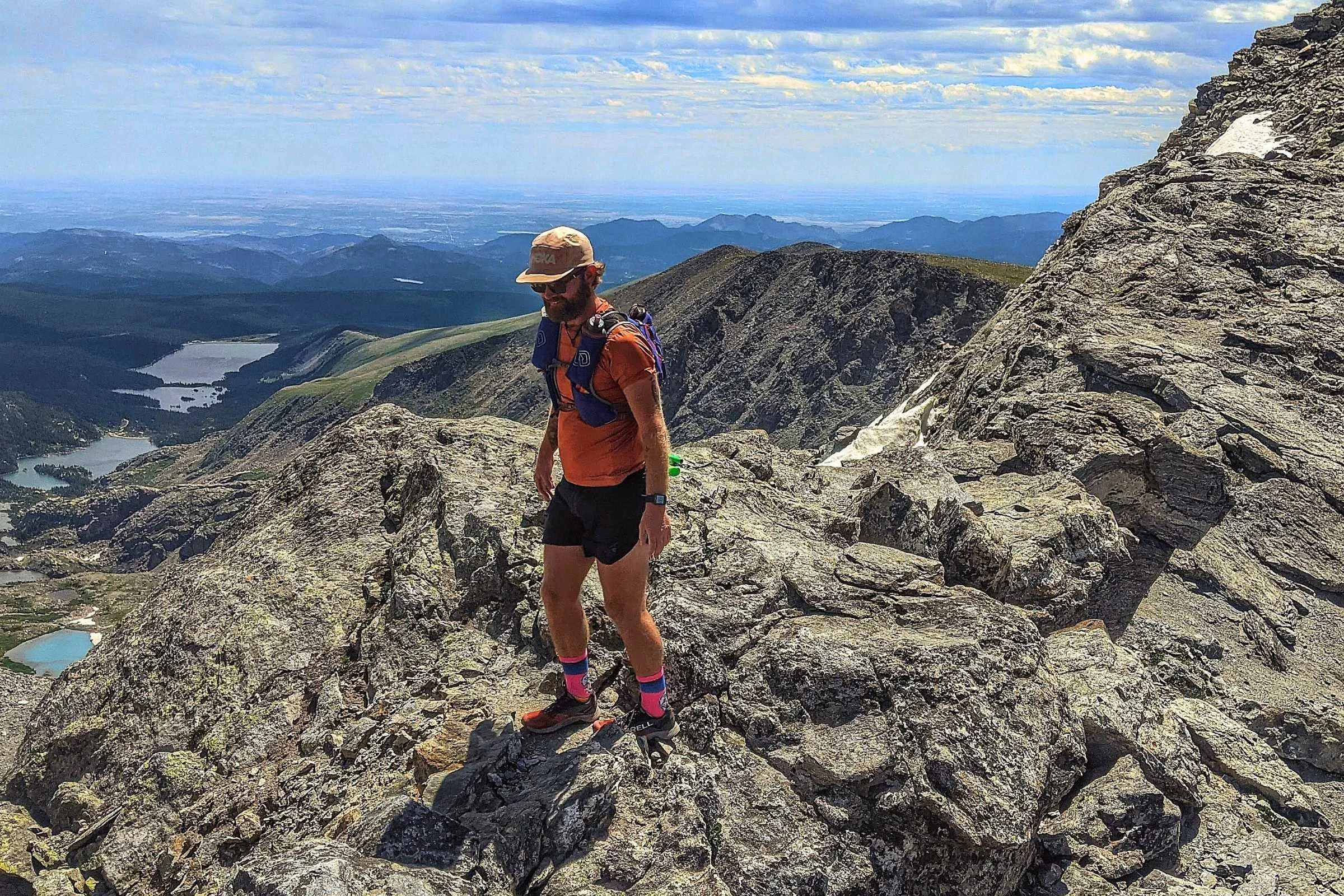
-
They have a Vibram Megagrip outsole, which is some of the grippiest rubber we’ve worn on any shoe in both wet and dry conditions. The outsole features 5mm lugs that bite into mud, and the sticky Vibram outsole also grips dirt and slickrock.
-
The Long Sky 2 trail runners have 4 mm of drop from heel to toe. The minimal drop, along with the not-too-tall 23.5-19.5mm stack height, makes these shoes feel very stable over rocky terrain. They aren’t the most cushioned, but they sacrifice cushion for maximum stability.
-
The FloatPro Foam midsole strikes the perfect balance between trail sensitivity and responsiveness. Despite the lower stack height, the dense foam effectively shields your feet while maintaining a firm, bouncy platform that feels good when you push off with every step.
-
The Long Sky 2's features include improved water drainage compared to the original version. Merrell claims they drain water 30% better, and while we can’t speak to specific percentages, they do seem to drain quickly and dry out fast.
-
They have a durable TPU-reinforced mesh upper. This upper lasted well over 300 miles, many of which were spent scrambling on granite and attempting to run across scree fields.
Merrell also has another version of these shoes, the Long Sky 2 Matryx, which features an even more durable Matryx upper fabric. This fabric combines multi-filament threads of Kevlar and high-tenacity polyamide to create a single layer of material that is lightweight with better breathability and abrasion resistance. The Long Sky 2 Matryx costs $20 more than the standard Long Sky 2, but $160 is a great deal for this shoe with a reinforced and more breathable upper.
-
The biggest drawback of the Long Sky 2 is that it doesn’t have a lot of cushion. We’ve run over 30 miles in these shoes multiple times, so they have enough cushion. They don’t have nearly as much underfoot padding as a max-cushioned trail runner, which many prefer for long days out. Again, we think the lower stack makes them more stable over rough terrain. But a low stack is less comfortable for some people.
-
Merrell may be known for its hiking boots, but the Long Sky 2 proves that it also makes excellent trail runners. For such an affordable price, we think these are definitely worth considering.
Best crossover shoe (for road and trail running): Hoka Challenger 7
Sizes available: 7-15
Widths available: Regular, wide
Drop: 5 mm
Stack height: Heel 31 mm; toe 26 mm
Weight: 8.9 oz / 252 g
What we liked: Lightweight, great for mixed surface runs, well-cushioned
What we didn’t like: Not the best on rough terrain
The HOKA Challenger 7 is an excellent crossover trail running shoe. We’ve been wearing the Challengers as our road running shoes for several years, and the newest iteration is lighter and has more stack height.
Every trail runner needs shoes for road running because there are days when you just want to run out your front door. If you’re like us, those runs follow city streets to the closest gravel or dirt path. The Challengers are an excellent choice for this style of running.
They’re not as light as many road-specific shoes, but they feel great on the gravel path that winds through your city park. We’ve put thousands of miles on the gravel trails of Denver’s parks over the years, and most of those miles have been in HOKA Challengers.
Read our full review of the HOKA Challenger 7.
Hoka Challenger 7



-
The Challenger has a similar design to the HOKA Speedgoat 6 but with smoother tread. They have tons of cushion, which we find more critical when pounding our feet over the pavement. They also have a great-fitting upper and a stable, supportive midsole.
-
We’ve tried “real” road running shoes for our best men’s road running shoes guide, but have always returned to the Challengers for their supportive and protective feel. Road shoes feel flimsy compared to these shoes, and we’re not used to that feeling.
If you’re more accustomed to the feel of road running shoes but want something that can also handle trails, we recommend the Salomon Aero Glide 3 GRVL. The Aero Glide GRVL shoes are much more akin to a road running shoe with a slightly grippier tread. On the contrary, the Challenger feels like a trail running shoe with a somewhat smoother tread. The Aero Glide GRVL feels faster but less beefy, like a road running shoe, whereas the Challenger feels burlier and more protective.
Since this is a trail running shoes guide, we think the Challenger is slightly better for trail runners who want a crossover shoe. However, if you're looking for something that leans more towards a road running shoe, consider the Aero Glide 3 GRVL (more on these below).
-
The biggest drawback of the Challengers, and any crossover shoes, is that they aren't the best for tearing up technical trails. They do better on steep inclines over strips of dirt than a road shoe, but they don’t provide nearly as much traction as trail shoes. We lace up these shoes when we plan to run a little bit of everything—sand, dirt, gravel, and pavement—the Challengers can handle it all. We don’t see any reason to use a different shoe for all those trails closer to home.
Best zero-drop trail running shoes: Altra Timp 5
Sizes available: 7 - 15
Widths available: Standard
Drop: 0 mm
Stack height: 29 mm
Weight: 9.8 oz / 278 g
What we liked: Grippy Vibram Megagrip outsole, natural foot shape, wide toe box, stable upper
What we didn’t like: zero drop isn’t for everyone, slightly narrower than the Altra Lone Peaks (which is also good for some people)
The Altra Timp 5 is our favorite zero-drop trail running shoe. It has awesome grip, fits well, and has just the right amount of cushioning. This is our favorite version of the Timp we’ve worn. It’s even better than the beloved Timp 2, which we wore while thru-hiking on the Pacific Crest Trail.
This is our favorite zero-drop shoe for long days on the trail, whether that’s running, hiking, or backpacking.
The Timp has slightly more grip and cushion than the extremely popular Lone Peak 9+ (more on that below). Though you can’t go wrong with the Lone Peak 9+, which now has Vibram Megagrip like the Timp, we still think the Timp 5 is best for most people.
Read our in-depth review of the Timp 5 here.
Altra Timp 5




-
When we tried the Lone Peak 9+, it made us rethink what we should recommend as the Best Zero Drop trail runner. At the end of the day, we still recommend the Timp 5 because they have slightly more cushion and will fit more people’s feet, but you can’t go wrong with either of these shoes.
If you have a wider foot and want a lower-to-the-ground shoe with less cushion, we recommend the Altra Lone Peak 9+. However, the Lone Peak is wide, even through the heel. Our main tester, Sam, has wider-than-average feet, and the Lone Peaks still feel wide to him. The addition of a Vibram Megagrip outsole on the Lone Peak 9+ makes them a very compelling option, but as we already said, we think the Timp 5 is slightly better for most people.
-
For everyone but those with the widest feet that one the most minimalist trail runners, we think the Timp 5 is best. If you prefer a zero-drop shoe with a wide toe box but have never found Altra Lone Peaks to fit your foot snuggly, you should try the Timps. The Timps are ever-so-slightly narrower, which we found works with our wide but not the widest feet. And the Timp 5 has more cushion, which is more comfortable on rocky, uneven terrain.
If you like the roomy toe box of Altra shoes but prefer more offset, Altra’s Experience Wild 2 trail running shoes, which we featured in our Outdoor Gear We’re Testing Fall 2025 article, have a 4mm drop.
-
The Timp’s tacky Vibram Megagrip outsole grips wet rocks and practically anything else. This is some of the most sticky rubber we’ve seen on any trail running shoe, and the same rubber used on the Hoka Speedgoat, Merrell Long Sky 2, and Altra Lone Peak 9+.
The Vibram Megagrip compound makes you feel like you’re wearing a climbing shoe, albeit one that fits like a runner. We can confidently smear on angled slick rock, rock hop across creaks, and even step on wet logs with the Timp 5 due to the Megagrip outsole.
-
The Timp 5 has just the right amount of cushioning. If you want a shoe with more cushioning that’s still zero drop, you should try the Altra Olympus, which has even more cushioning. But, we like the amount of cushioning on the Timps–it’s not too little but not too much either. The Timp 5 also has a new Altra EGO MAX compound midsole. This midsole offers an excellent cushion without feeling too soft when you push off.
-
The Timp 5 is also available as a high-top hiker version for people who prefer a lightweight hiking boot. It’s also available in a BOA version, The Timp 5 Boa, which costs $175. This new BOA version of the Timp is mostly identical to the standard Timp 5 except for the BOA tightening mechanism and a $20 price increase for that BOA system.
The BOA dial and lacing make tightening and loosening the shoe much faster and easier—you can literally tighten or loosen these with one hand. This is nice if you prefer to have your shoes tighter for downhill sections but aren’t the type to stop, untie, then retie your shoes to make them tighter. Normally, we keep our shoes laced at the same tightness all day, but with a BOA, that doesn’t have to be the case. They also never come untied, which is pretty great.
To be honest, we weren’t convinced that paying extra for BOA dials on your shoes was worth it, and we still feel like that guy with the fancy-looking shoes when we’re wearing shoes that would work perfectly fine with standard laces. But for the price of a burrito and horchata, we’re now mostly sold on the BOA lacing system as long as it isn’t our last $20 (in which case, burrito!).
-
If you’re looking for a zero-drop trail running shoe with stellar grip, plenty of cushion, and a wide but not too wide fit, you should check out the Timp 5, or upgrade to the Timp 5 BOA if it’s not your last $20.
Best for Traction: La Sportiva Mutant
Sizes available: 40.5 - 47.5
Widths available: Standard
Drop: 10 mm
Stack height: 26 -16 mm
Weight: 11.2 oz / 317 g
What we liked: excellent traction, gets grippier with more use, locked-in fit
What we didn't like: specialized use
The Mutant is one of the most unique trail running shoes we’ve ever worn. They’re incredibly grippy and feel closer to an approach shoe than a running shoe in many ways. But they are a trail running shoe, a running shoe that’s more suited for off-trail mountain runs and scrambling routes than smooth dirt tread.
We primarily wear the Mutant for peakbagging missions or other runs that involve a lot of scrambling. They’re ideal for alpine ridgelines, smearing on slick rock, and summiting 14ers. We’ve tested them in Utah slot canyons, high routes in Colorado’s Weminuche Wilderness, and class 4/5 scrambles to mountain summits. These shoes are wildly popular with trail runners who blur the line between running and climbing, and for good reason—there’s nothing else like the Mutant.
La Sportiva Mutant

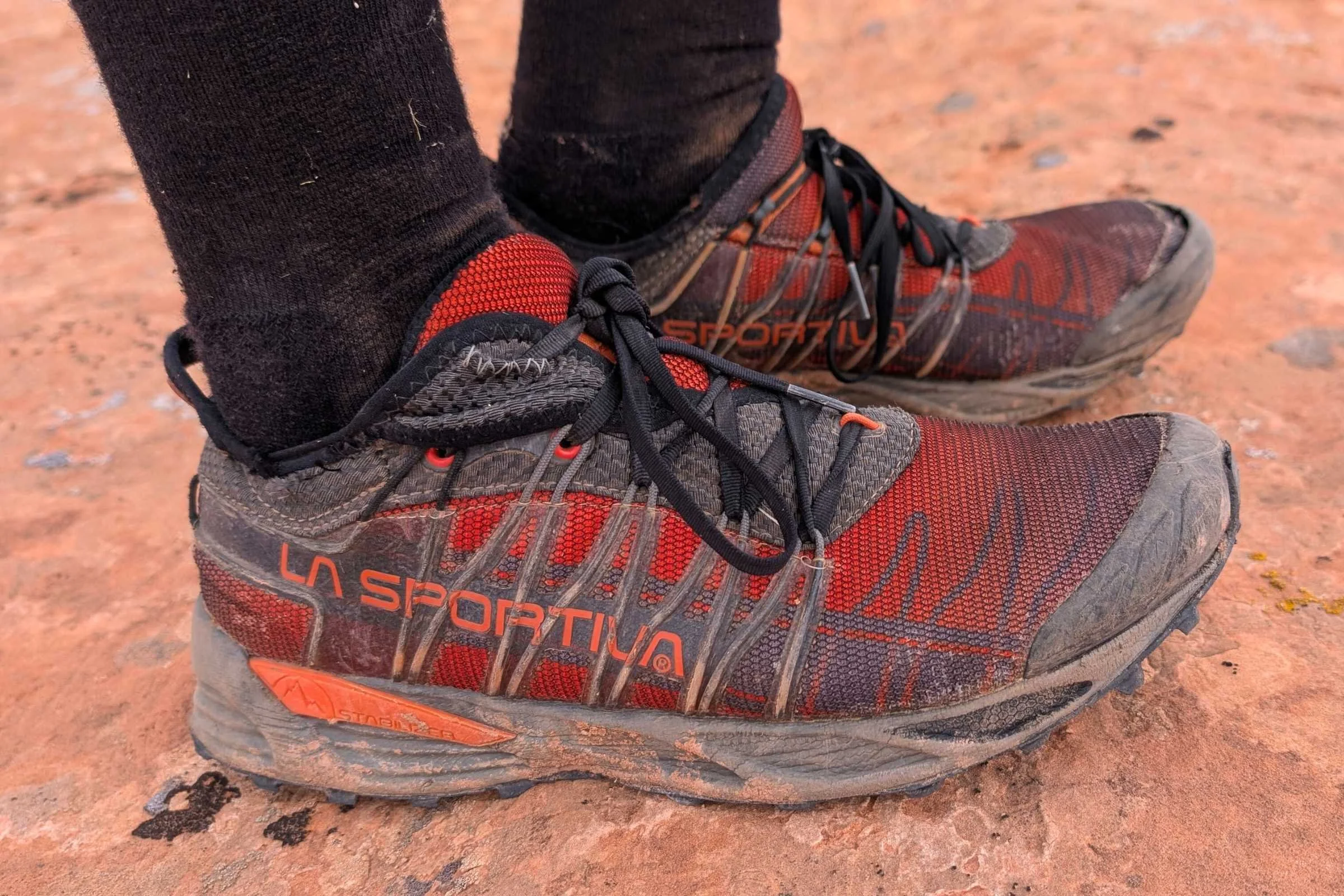
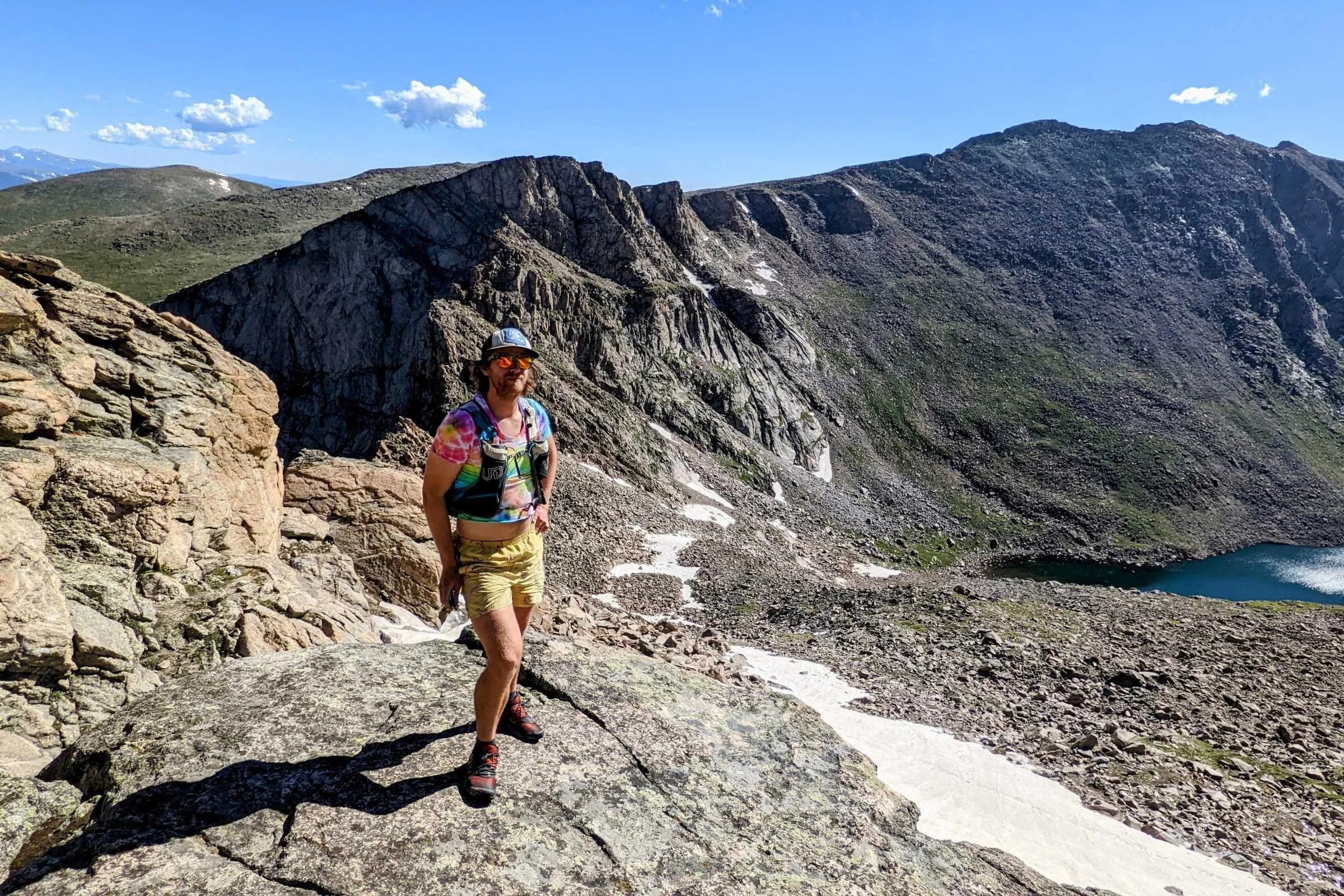

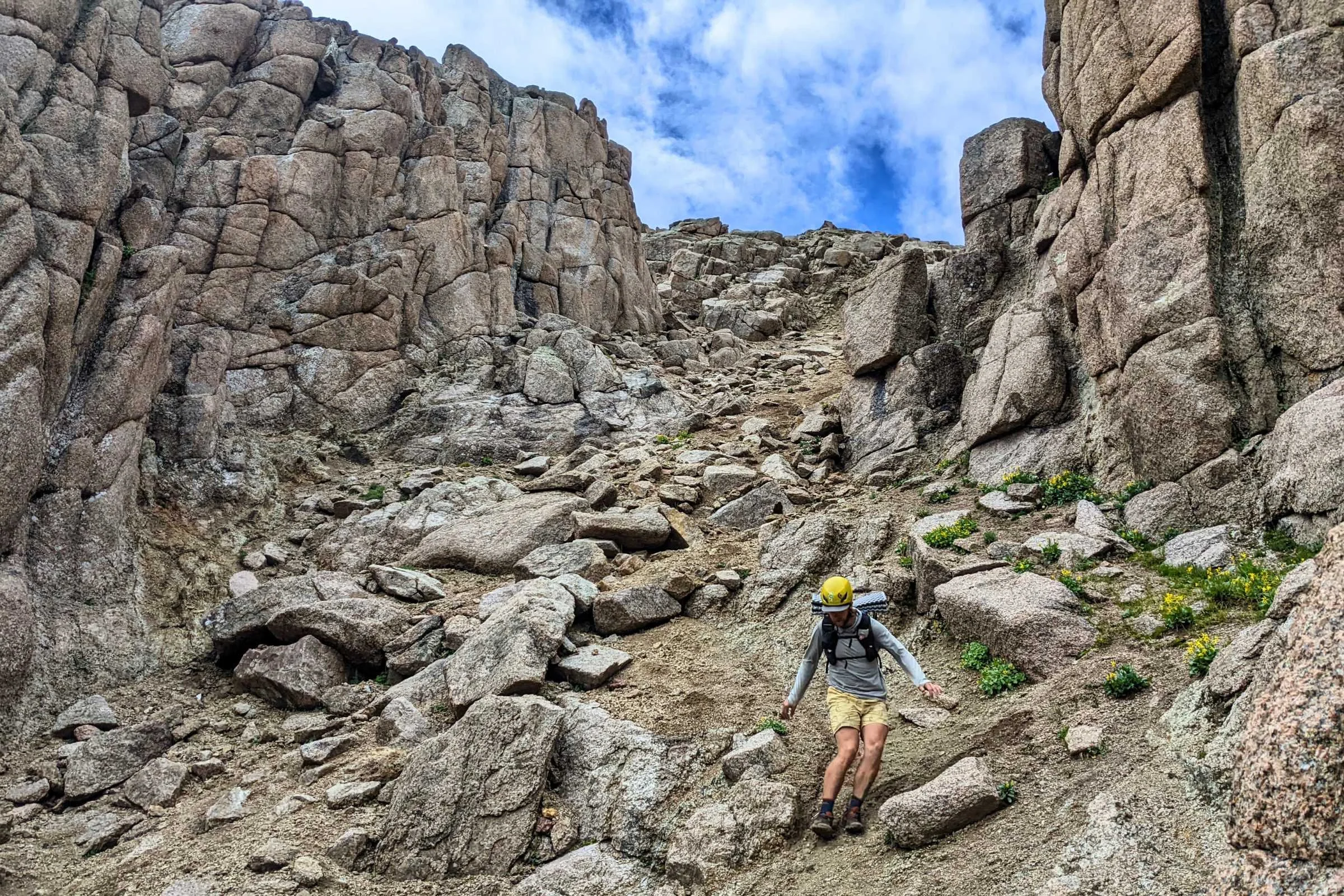
-
The Mutant outsole is seriously sticky. We once dropped off a boulder blocking a slot canyon, then caught ourselves out of a free-fall by stemming across with our feet when the slick rock walls narrowed below. The outsole rubber grips smooth, near-vertical walls as well as rock shoes.
-
They have massive 6mm lugs that give responsive grip on hardpack, loose dirt, and mud. With a new pair of these shoes, you don’t get much surface area to grip onto rock due to the lugs, but those lugs will seriously bite into soft dirt and mud. They grip well on rock even with the lugs, and will only become better at smearing as the lugs wear down.
-
The upper features a very unique lacing and tongue system that hugs around your foot, providing a secure, locked-in fit. There isn’t a tongue on these shoes, though. Instead, both sides of the shoe overlap across the top, where the tongue on a traditional shoe would be.
-
The lacing system allows you to tighten the shoe evenly by going beyond simply pulling the shoe up along the top. Each lace segment weaves through cord loops laminated along the sides of the shoe, extending to the midsole. Then, at the top of the shoe, where the two sides overlap (in lieu of a tongue), the outside end of the shoelace weaves back and forth through the material. When you lace up these shoes, you feel them tighten along the sides and securely across the top of your foot. The wraparound tongue makes them feel solid even when not tied. But once you tighten the laces, your foot isn’t moving.
We recently had to replace the shoelaces on our pair. While the lacing pattern creates an incredibly supportive upper, retracing that pattern proved infinitely more complicated than lacing up any shoes we’ve ever worn.
-
The biggest drawback of these shoes is that they aren’t very versatile. We’ve used them for more traditional trail runs on hardpack dirt and rocky trails, and they work for this. But they don’t feel fast, and feel like too much shoe for anything but the most gnarly terrain. They’re also pretty narrow and can leave your toes feeling cramped during long days on the mountain.
-
These are certainly not the do-it-all trail runners of your dreams, but they don’t try to be. They could be the don’t look down, I should be wearing climbing shoes trail runners of your dreams, though.
Best gravel shoe: Salomon Aero Glide 3 GRVL
Sizes available: 9 - 13
Widths available: Standard
Drop: 8 mm
Stack height: 40 - 32 mm
Weight: 9.7 oz / 275 g
What we liked: right among of traction and cushion for gravel trails
What we didn't like: niche chose not best for all situations
The Salomon Aero Glide GRVL is another crossover shoe intended for running on gravel roads. They’re very similar to the Salomon Aero Glide 3 road running shoes, but have added traction to the outsole in the form of shallow lugs. The outsole looks pretty similar to our gravel bike’s tires, which makes sense, given that these are gravel shoes.
Much like how gravel bikes are a cross between a road bike and a mountain bike, the Aero Glide GRVL isn’t a full-on trail running shoe, but it works better on trails than other road running shoes. If you regularly run on remote roads with varied surface quality, these are ideal. They’re also fantastic if you like running out your front door to gravel and dirt paths before returning home on paved roads.
Salomon Aero Glide 3 GRVL
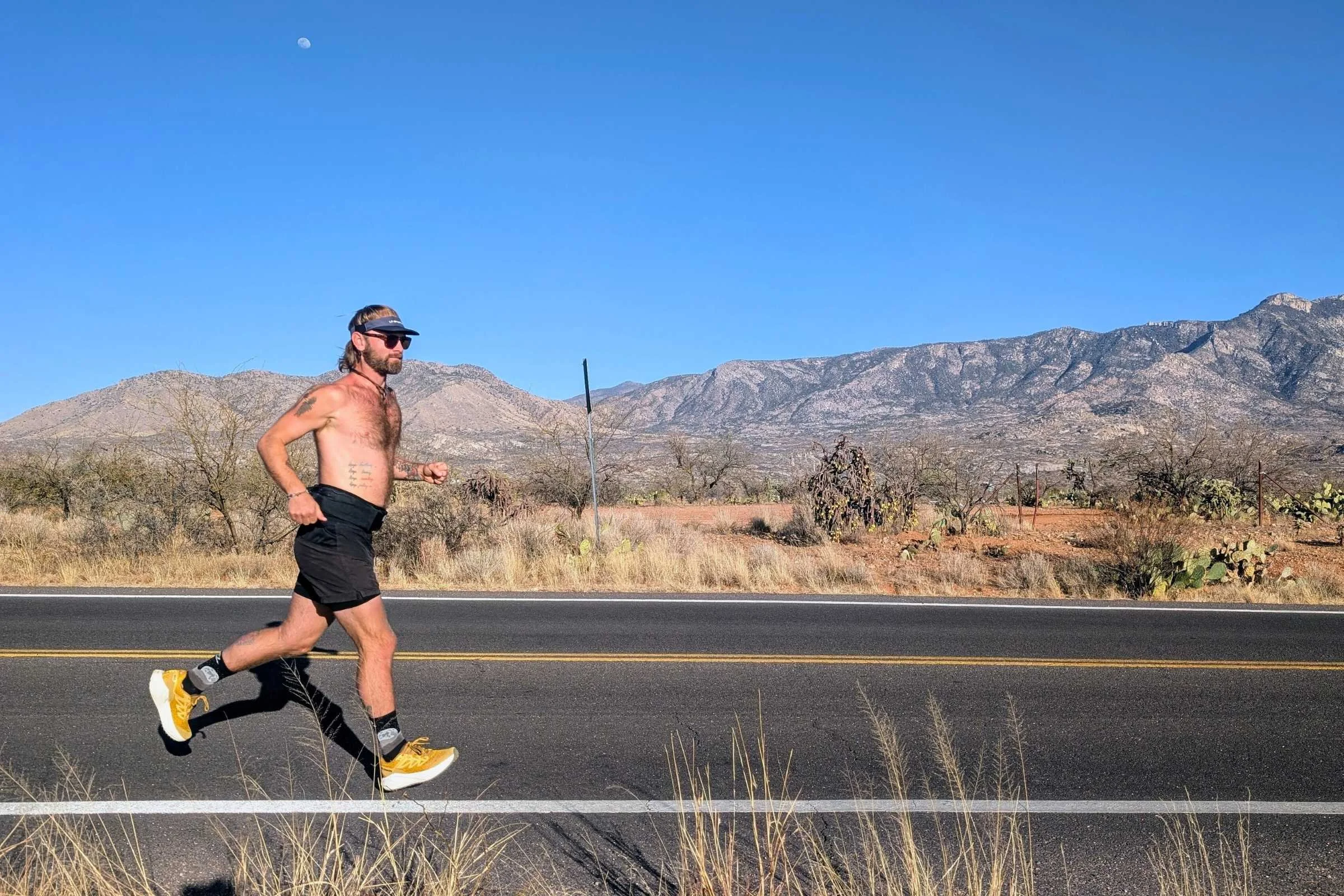
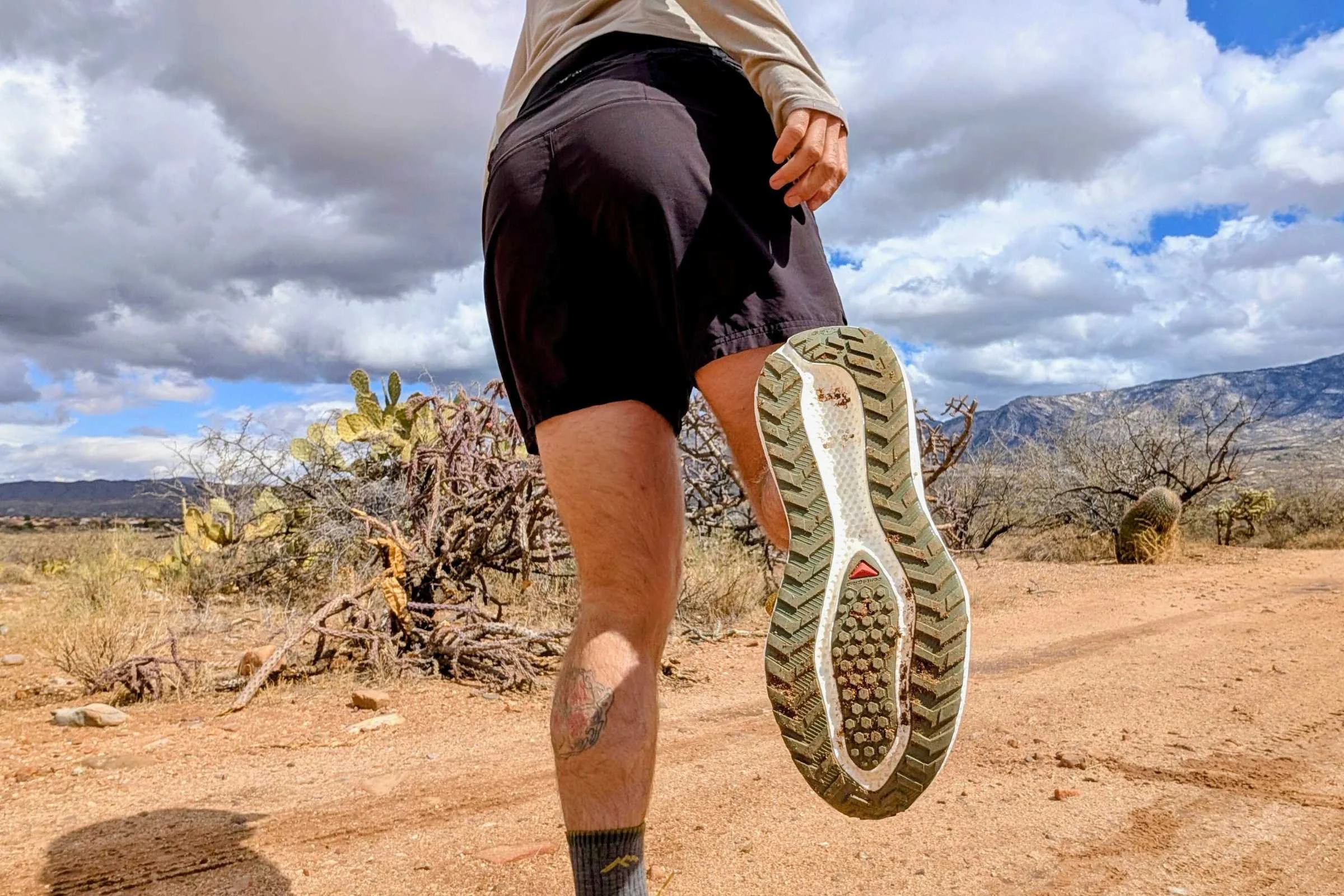
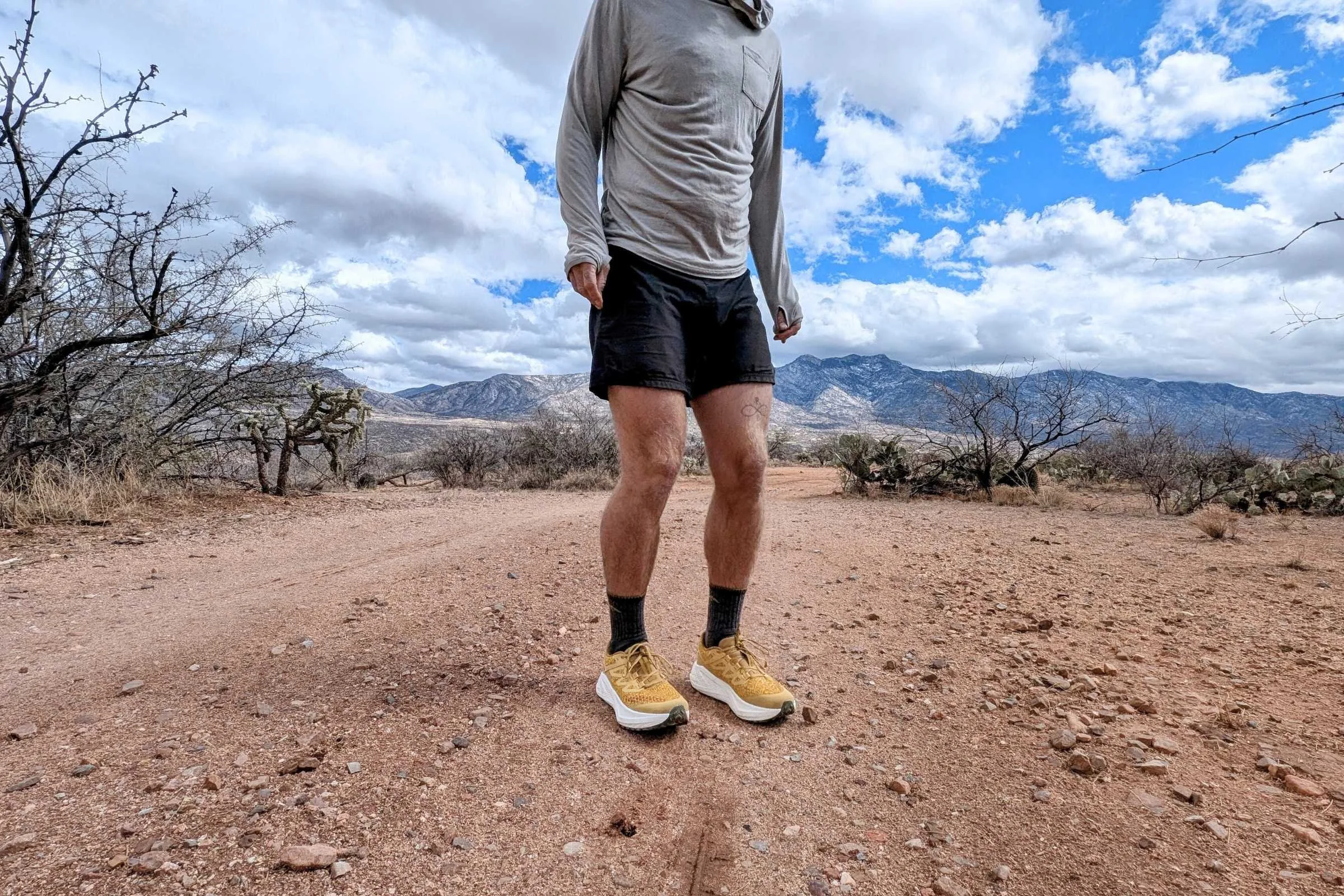
We like these shoes a lot and include them in our Road Running Shoes guide as well. But, they’re niche shoes that shouldn’t be the first trail running shoes you buy. We also think they feel slightly more like a road running shoe than our top crossover shoe pick, the Hoka Challenger. The Aero Glide 3 GRVL can hold its own on smooth trails, but it feels best suited for running on gravel and dirt roads.
If you like the sound of these and feel like they’d fit where you like to run, go for it.
Best waterproof trail running shoes: La Sportiva Cyklon Cross GTX
Sizes available: 6-13.5
Widths available: Standard
Drop: 8 mm
Stack height: 28 mm
Weight: 12.5 oz / 355 g
What we liked: Integrated waterproof gator, excellent traction, BOA dial lacing
What we didn’t like: Very expensive, La Sportiva sizing runs small
The La Sportiva Cyklon Cross GTX are the best waterproof trail running shoes we’ve worn. Many trail runners come in a waterproof version, but few others feature a full-coverage integrated waterproof gaiter like these. Thanks to the Cyklons, we could trail run five or more days a week during a very snowy January in Colorado. We ran hundreds of miles on trails, climbed 14ers, and snowshoed in these fully waterproof shoes. The waterproof gaiters kept our feet dry and warm even in temperatures near zero degrees Fahrenheit. You don’t have to worry about puddles splashing into the top of your trail shoe and soaking your feet when wearing the Cyklons. They have transformed our winter and wet-weather trail running.
See our in-depth review of the La Sportiva Cyklon Cross GTX trail running shoes for more information.
La Sportiva Cyklon Cross GTX




The Cyklons feature a full-coverage waterproof gaiter that extends above your ankle. The gaiter zips shut over a BOA lacing system. The BOA dial is outside the waterproof gaiter and is easy to operate with gloves or waterproof mittens. This feature lets you easily tighten or loosen the shoes as trail conditions change. They also have deep 6.5-millimeter lugs with La Sportiva’s stickiest rubber. The lugs bite into snow and mud very well. We rarely felt the tread wasn’t enough on its own, and we only needed to add microspikes when running on smooth ice. The shoe that sits inside the integrated gaiter is very comfortable, too. Over many full days on rough trails, they remained comfortable.
However, the Cyklons are expensive. If you’re a hardcore foul-weather runner, they’re worth it. We’ve already convinced a few of our trail-running friends they’re worth the price this winter, and no one who’s tried them has been disappointed. But if you only plan to run trails a handful of times when it’s cold and wet, they might not be worth it.
Other Trail Running Shoes We Tested
Sizes available: 7.5 - 13
Widths available: Standard
Drop: 6 mm
Stack height: 34 - 28 mm
Weight: 8.9 oz / 252 g
What we liked: Responsive midsole, energy transfer and stability, well-cushioned, stable upper, grippy outsole, excels on any terrain, durability,
What we didn’t like: price
La Sportiva recently released a Prodigio Pro version of the beloved Prodigio. The Pro, which costs $40 more, features a “power wire” mesh upper—a network of small TPU wire overlays that wrap up and around the mesh material. The power wire upper aids in energy transfer and stability. It also improves the durability of the upper, since all those wires aren’t likely to tear as easily as the mesh. The upper also wraps around the ankle like a gater, which keeps debris out of your shoes.
La Sportiva Prodigio Pro
The Prodigio Pro also features a super critical EVA foam midsole. Super critical EVA, commonly used in running “super shoes,” uses nitrogen injected into the foam during manufacturing to create a lighter and bouncier midsole than standard EVA. The Prodigio Pro’s midsole feels awesome, hands down. Unlike many super shoes, the Prodigio Pro doesn’t have a carbon plate, which we think is overkill for trail shoes and makes them less useful as a daily trail runner.
The Prodigio Pro is a huge improvement over the standard Prodigio. If the Pro didn’t cost $195, we would recommend it over the standard Prodigio. However, we just can’t bring ourselves to recommend a shoe that costs that much more for everyone. If you have an extra 40 bucks, the Prodigio Pro is a stellar shoe, but the standard Prodigio is also great. You can’t go wrong with either choice.
We love the Altra Lone Peak zero-drop running shoe and think the Lone Peak 9 and 9+ are an improvement over the previous version, the Lone Peak 8. With previous versions of the Lone Peak, which used Altra’s proprietary MaxTrac outsole, we didn’t think it was as grippy as the Vibram Megagrip outsole uses on the Timp 5. However, with the Altra Lone Peak 9+, you can have the Lone Peak platform with Vibram Megagrip as well.
Sizes available: 7-16
Widths available: Regular, wide
Drop: 0 mm
Stack height: 25 mm
Weight: 11.2 oz / 317 g
What we liked: Zero drop, wide toe box, great trail feel, minimalist shoe, available in many sizes, 9+ version has sticky rubber outsole
What we didn’t like: Not great on technical terrain, minimalist trail shoe feel isn’t for everyone
The Altra Lone Peaks are some of the most popular zero-drop trail running shoes. Altra has a massive following among trail runners, thru-hikers, and ultralight backpackers who want a shoe that allows your foot to move naturally with room to accommodate foot swelling in extreme conditions. The Lone Peak was our previous top pick for a zero-drop shoe. But it was unseated by the Altra Timp 5 last year when the Timp was upgraded to a Vibram Megagrip outsole. Now, the Lone Peak 9+ has gotten the same treatment. The Lone Peak 9+, and not the standard Lone Peak 9, now has a Vibram Megagrip outsole. We love the Lone Peak 9+ so much we wrote a whole review about them.
Altra Lone Peak 9+



The addition of Megagrip to the Lone Peak 9+ makes it on par with the Timp 5 in terms of grip. We think the Lone Peak 9+ is a great shoe, but the Timp has more cushion and is slightly narrower throughout, making it slightly more stable on technical terrain. If you need a wider zero-drop shoe than the Timp, you should get the Lone Peak 9+. Also, if you simply love the Lone Peak, don’t let us deter you from getting them. Now that the Lone Peak 9+ has Vibram Megagrip rubber, there are even more reasons to love this legendary shoe.
We first wore Lone Peaks while thru-hiking the Pacific Crest Trail, and have tested Lone Peak versions 1 through 9+ at this point. We tested the Lone Peak 9+ trails in Arizona, Colorado, and New Mexico. These shoes excel on smoother trails – they’re great for running over sand and packed dirt in desert environments. The minimalist design is quite popular outside desert regions, too. With the addition of the Vibram Megagrip in the 9+, they’re much better on slick rock and in other scrambling scenarios as well.
These are zero-drop shoes, meaning your heel is at the same level as your forefoot – how it would be when you’re barefoot. The toe box is very wide, so your toes don’t rub each other as you move. The result is an incredibly comfortable trail shoe that is less prone to causing blisters or chafing.
The Lone Peaks have a relatively low stack height, so you’re close to the ground and can feel the trail beneath your feet, further adding to the natural barefoot feel. They're constructed with a seamless and stitchless upper, making them even less prone to discomfort from chafing or rubbing. The upper is almost entirely mesh, making these some of the most breathable shoes we tested. The wide platform creates a very stable feel. The tread is grippy, and the deep directional lugs help grip loose dirt and sand.
However, some people don’t love how the minimalist design makes them feel less stable. If you’re used to a more rigid trail shoe, they'll feel flimsy, especially at first. We noticed this on rocky trails where the shoes didn’t feel as protective. However, if you’re looking for a zero-drop trail runner, you probably know the benefits of this design.
Note that the sizing of the 9s is slightly larger than the 7s. When testing the Lone Peak 9+, we went with a half-size smaller than usual, which greatly improved how they felt on our feet. If you want the widest zero-drop shoe, we recommend the Lone Peak 9+. If you want a slightly narrower zero-drop trail shoe, we also love the Altra Timp 5.
Related: read our review of the durable, zero-drop Topo Athletic Pursuit 2 for another good comparison.
Sizes available: 7-14
Widths available: Standard, wide
Drop: 4 mm
Stack height: Heel 28 mm; toe 24 mm
Weight: 9.4 oz / 266 g
What we liked: Lightweight, aggressive lug pattern, more cushioning than previous versions, wrap-around tongue
What we didn’t like: Narrower fit
Saucony has been making the Peregrine trail running shoe for over 16 years. The latest version, the Saucony Peregrine 14, maintains the lightweight design we loved in previous versions but with an even more cushioned midsole. We love how responsive this updated midsole feels while still cushioning our feet for long days. Saucony added more cushion with the 13 version, but they stepped it up with their PWRRUN cushioning and PWRRUN+ sock liner on the 14s.
The Peregrine has a very comfortable upper and generous cushioning around the heel and ankles. You can hike or run in these shoes without lacing them very tight because the tongue attaches to the footbed, so it wraps around your entire foot like a bootie. When you tightly lace them, it creates a cozy, glove-like fit. The well-fitting upper creates a super stable feel, and we love how these shoes feel on technical descents.
The outsole features 5-millimeter multi-directional lugs that work well in most conditions. Their PWRTRAC rubber is tacky enough to grip on slick rock surfaces, though it isn’t quite as sticky as the Vibram Megagrip rubber on the Hoka Speedgoat 5 and Merrell Long Sky 2 or the Frixion® XT 2.0 rubber on the La Sportiva Jackal II. While we like most things about these shoes, they run on the narrower side and don’t have quite enough room in the toe box to be our go-tos for long runs. But if you have narrower feet or prefer a tighter fit for technical running, these shoes are an excellent option.
Read the full review of the Saucony Peregrine 14 for more details.
Saucony Peregrine 14
Saucony has recently come out with a Peregrine 15, which we are currently testing and will report back.
Sizes available: 7-15
Widths available: Standard
Drop: 6 mm
Stack height: Heel 22 mm; toe 16 mm
Weight: 9.4 oz / 266 g
What we liked: Extremely comfortable, lightweight, nimble, grippy rubber outsole
What we didn’t like: Price
The Brooks Catamount 3 is one of our new favorite trail running shoes for almost everything, but it’s especially good at tackling hills. We took this on several 10+ mile runs to the top of peaks in southern Arizona and were impressed with how they feel as you push off the ground on inclines. They’re lightweight and springy, making long runs to the top of a mountain feel fun. They’re also super stable on the downhills. These are all-around great trail runners.
The Catamounts have a sticky outsole, with 4-millimeter lugs deep enough to grip loose dirt or mud. They have a built-in plate that stiffens the sole and propels you forward as you push off with your toes. Though this isn’t a “rock plate,” per se, it also protects the bottoms of your feet as a rock plate would. The tongue connects to the shoe's insole area, giving these shoes a bootie-like feel and keeping your foot secure inside the shoe.
We love how this upper fits around our feet and immediately felt confident on the downhills with these shoes. The upper mesh is super breathable, too. These are some of our new favorite shoes for hot weather runs. However, these are some of the more expensive trail running shoes we tested. There are less expensive shoes out there that perform almost as well, and if you’re just starting, we would steer you in that direction instead. The Catamounts are a great option if you’re looking for a high-performing, speedy trail runner capable of technical terrain.
Brooks Catamount 3
Brooks has recently come out with a Catamount 4, which we are currently testing and will report back.
Sizes available: 7-14
Widths available: Standard
Drop: 8 mm
Stack height: Heel 20 mm; toe 12 mm
Weight per shoe: 11 oz / 312 g
What we liked: Extremely stable, durable, supportive midsole
What we didn’t like: Heavy, not the most comfortable
The Brooks Cascadia 17 is a legendary trail running shoe that’s been around for 17 iterations. We think the latest iteration is a great shoe, but we think the Brooks Catamount 3 is a better all-around trail shoe for its lightweight design and higher level of comfort. The Brooks Cascadia is a great shoe, though, and plenty of trail runners and hikers swear by it.
Brooks Cascadia 17
Brooks has recently come out with a Cascadia 18, which we are currently testing and will report back.
Sizes available: 7-14
Widths available: Standard
Drop: 11 mm
Stack height: Heel 28.7; toe 17.3 mm
Weight per shoe: 11.4 oz / 323 g
What we liked: Extremely protective, stiff midsole
What we didn’t like: Feel more like a hiking shoe than a runner
The Salomon XA Pro 3D have been around for nine iterations. They’re a very popular shoe for hiking and backpacking, even though Salomon lists these as a trail runner. These shoes have a very firm midsole that feels great when picking your way through rough, rocky trails. They have a grippy outsole that works in wet conditions.
With the most recent version, Salomon has made these shoes lighter and more responsive than previous versions, but they still don’t feel as nimble as many of the other trail runners we tested here. However, if you’re looking for a durable shoe to transition away from hiking boots or even lightweight hiking boots, this is a great option.
Learn more in our in-depth review of the Salomon XA Pro 3D V9 shoes.
Salomon XA Pro 3D V9
Sizes available: 6 - 13.5
Widths available: Standard
Drop: 12 mm
Stack height: Heel 29; toe 17 mm
Weight: 12.37 oz / 328 g
What we liked: Super durable, breathable, sticky rubber outsole
What we didn’t like: Runs narrow, La Sportiva sizing runs small, better for fast hiking than trail running
The La Sportiva Wildcat was our former winner for best light and fast hiking shoe. Often “running” long distances means "fast hiking" as much as it does running. The Wildcat is relatively heavy compared with other trail running shoes we tested, but it’s also one of the most durable and protective shoes. It's a very popular shoe with long-distance thru-hikers, and we’ve seen multiple pairs of these shoes last for nearly 1000 miles. While we wouldn’t recommend relying on a single pair of these shoes for that long, we can confirm it has been done.
La Sportiva Wildcat
The Wildcat is “overbuilt” by modern trail running shoe standards, but we think that's a good thing for the right uses. It has a burly toe cap, and stiffer soles than many trail runners. With a unique lug pattern made of long, thin rubber cleats that run lengthwise, they do well in rough terrain and feel more akin to the tread of a hiking shoe than a runner. The outsole rubber is quite sticky, and the shorter lugs allow for a solid platform to grab onto smooth rock. The upper is a comfortable and airy mesh with synthetic leather overlays for durability. They breathe well and kept our feet comfortable in hot conditions.
Though the Wildcat is excellent for long distances, it doesn’t have as much cushioning as some trail runners. They have a firmer midsole that doesn’t compress quickly, so they don’t have that cloud-like cushion feeling. While this isn't a dealbreaker for us, it might not be best if you prefer that soft, cushioned feeling of modern trail running shoes. The Wildcat is an excellent option for light and fast hiking. And let’s be honest, not all “trail runs” have to be 100% running because most of us can’t run over everything.
Sizes available: US Men’s 6-14.5 / EU 38 - 48.5
Widths available: Standard (D)
Drop: 7 mm
Stack height: Heel 29 mm; toe 22 mm
Weight: 9.7 oz / 275 g
What we liked: Lightweight, great fit, comfortable tongue, grippy tread, wider than most La Sportiva shoes
What we didn’t like: La Sportiva sizing runs small
The La Sportiva Jackal II trail running shoes are lightweight trail runners that balance foot protection, grip, and all-day comfort very well. These shoes have a wide toe box that makes them great for long, ultra-distance trail adventures, but their all-day comfort also translates well to any length run.
We’ve worn the Jackals since the original version for everything – from backpacking the Arizona Trail across the Grand Canyon to running trails in Colorado, New Mexico, and Arizona. We even use the Jackals for “road to trail” type runs, where we start on pavement and eventually end up on dirt or gravel surfaces.
You can read our in-depth review of the La Sportiva Jackal 2 here.
La Sportiva Jackal II
The Jackal II has a wider last than most other La Sportiva shoes, which have a reputation for running relatively narrow (see our shoe diagram for an explanation about lasts). We loved the original Jackals but had some issues with the heel fit and comfort. The Jackal II has a much-improved heel that fits better, especially with this heel lock lacing technique. They have plenty of room in the toe box for long days on the trail. However, unlike some trail runners with wider toe boxes, these shoes are super stable on rocky, technical terrain.
The Jackal II tread is some of the grippiest we’ve used. They feel secure while hopping from rock to rock or making sharp cuts around a downhill switchback. They also have a highly breathable upper, which helps on those long, hot days. The biggest drawback of these shoes is the fit. With all La Sportiva shoes, we have to get a full size bigger than we usually wear with other brands’ shoes. Once we figured out sizing, they fit really well and are wide enough for our wider-than-average feet.
There aren’t many shoes that work this well for anything the trail throws at you, and we love the Jackal II for that reason. They used to be our favorite trail runner overall, but they’ve since been usurped by the La Sportiva Prodigio. If you want the La Sportiva model with the widest toe box, this is still the shoe for you.
Sizes available: 7 — 14
Widths available: Standard
Drop: 8 mm
Stack height: Heel 29.6; toe 21.3 mm
Weight: 10.1 oz / 286 g
What we liked: Affordable, Salomon quicklace system, comfortable, stable
What we didn’t like: Narrow fit
The Salomon Sense Ride 5 are some of the least expensive trail running shoes we tested, but they perform as well as many more expensive shoes. We’ve worn many pairs of the Sense Ride over the past few years. We love the overall stable feeling of the upper and the generously cushioned yet bouncy midsole they’re built on. These shoes do everything well and come in a lightweight package that pushes you to run farther.
Read our in-depth review of the Salomon Sense Ride 5 for more details.
Salomon Sense Ride 5



Sizes available: 7-14
Widths available: Standard, Wide
Drop: 10 mm
Stack height: Heel 32 mm; toe 22 mm
Weight: 10.5 oz / 298 g
What we liked: Great traction, quicklace system, very protective, comes in standard and wide sizes
What we didn’t like: Feels like overkill on flatter terrain
The Salomon Speedcross 6 is a stellar trail running shoe for muddy, steep, or technical conditions. These shoes give you some of the best traction of any trail shoe available. Their massive 5 mm lugs bite into soft dirt and mud, and the sticky rubber grips onto slickrock and loose hardpacked dirt as well.
This shoe is designed for rough trails and has a stable, protective upper. The updated Speedcross 6 has a revamped upper material that feels more like a knit sock than previous versions. This revamped upper is more comfortable than previous versions, which were already quite comfortable. Other than the updated upper, the Speedcross 6 is largely the same as the Speedcross 5. They still lace up with the Salomon quicklace system, which tightens in one motion and never comes untied. The quicklace system paired with this new knit sock-like upper feels great even when you really tighten the laces.
For more info, read about our in-depth testing in our full Salomon Speedcross 6 Review.
Salomon Speedcross 6
Stack: 25-19 mm
Drop: 6 mm
Weight: 10.5 oz
What we liked: Grippy, stable, low to the ground, comes in wide sizing
What we didn’t like: Not very much cushion, heavier, La Sportiva sizing is weird
The La Sportiva Bushido III is a low-stack trail runner for technical terrain. This is one of the most stable-feeling shoes we’ve tested. It doesn’t have the most cushioning and wouldn’t be our top choice for ultra-distance endeavors. But it has enough cushioning, and this shoe shines in its traction and stability, not cushioning. Now that the Bushido III comes in wide, which is new for this year, we recommend it to anyone looking for a stable shoe with excellent traction that’s low to the ground.
We’ve been a fan of the Bushido for years but never found they fit our feet well. Older Bushido models are probably one of the biggest culprits for La Sportiva’s reputation of having narrow-fitting shoes. We wanted to love these shoes for techy, rocky terrain, but they felt too much like a ballerina slipper for longer runs.
You can read our in-depth review of the La Sportiva Bushido III here.
La Sportiva Bushido III
While the Bushido III may not offer as much cushioning as the Altra Timp, Hoka Speedgoat, or La Sportiva Prodigio, it provides enough for longer 10-20 mile runs. We've tested it on 20-mile runs and found it cushioned enough for that distance, but longer than that is too much.
The Bushido outsole has a grippier rubber in the middle, with a slightly harder rubber around the edges. This provides traction where you need it with a longer-lasting rubber on the sides of the outsole, where shoes tend to wear out faster. These shoes are fantastic for scrambling and smearing on slick rock. And after several months and nearly 200 miles of use, the outsoles still look pretty fresh.
These are shoes we grab for the techiest runs, where you can’t actually run the entire time because the terrain is too steep, rocky, and exposed. If that’s the terrain you like to get after, this is the shoe for you.
Sizes available: 40 - 48
Widths available: Standard
Drop: 4 mm
Stack height: 26.5 - 22.5 mm
Weight: 9.9 oz / 280 g
What we liked: durability, incredibly grippy, built in sock linger keeps debris out, stability
What we didn’t like: very niche
The Scarpa Ribelle Run 2 is designed for running on burly trails. They feature a built-in sock liner to prevent debris from entering, reinforced overlays throughout the upper, and a grippy rubber outsole with 6mm lugs. These shoes have the look and feel of a lightweight mountaineering boot mixed with an approach shoe.
We tested these shoes running in the Bisti/De-Na-Zin Wilderness badlands of northwest New Mexico, as well as on off-trail routes in southeast Utah and Colorado. They’re well-suited for technical, rocky terrain, are incredibly grippy on steep trails, and the built-in sock liner keeps debris out.
Most trail running shoes feature a reinforced toe cap, but these shoes take it a step further. They feature a rubber strip that extends from the heel to the toe, covering the midsole and leaving no exposed foam on the sides of the shoe except around the heel cup. There is also no exposed midsole foam on the tread. This is an ideal design for extremely rocky terrain, where sharp rocks can tear up the midsoles of traditional trail runner shoes.
Scarpa Ribelle Run 2
They have a 26.5-22.5mm stack with a 4mm drop. This is a relatively low amount of drop, which creates better stability on uneven terrain. We like these shoes overall, but they’re quite stiff, and we wish they provided a better trail feel.
The Ribelle Run 2 is a great trail running shoe for those accustomed to wearing mountaineering boots, but we know that’s not everyone. These are perhaps even more niche than the La Sportiva Mutant and cost more.
Sizes available: 7.5 - 13
Widths available: Narrow
Drop: 6 mm
Stack height: 29 - 23 mm
Weight: 9.6 oz / 270 g
What we liked: light, fast, grippy, traction, changing directions and braking, refined fit
What we didn’t like: narrow, price
The Rossignol Vezor trail running shoes are light, fast, and grippy. These shoes are designed for technical trails and high-elevation running. We tested these while running in the La Sal Mountains of southeast Utah.
They feature a Michelin-formula rubber outsole with 4mm lugs. This outsole provides good traction on varied terrain and works well for changing directions and braking.
The most unique feature of these shoes is the three-part removable footbed system that allows you to refine the fit. In reality, this means the shoes come with two insoles. On the first run, we found the shoes to be very tight-fitting, so we removed one of the two insoles to “customize” the fit. Now that we only have one set of insoles, the shoes fit better, but they still run very narrow.
These shoes are best for short and fast technical trails, skyrunning, and for people with narrow feet. They’re more expensive than many shoes we tested here, yet they don’t perform better. They feel like a narrower version of the Merrell Long Sky 2 that costs $40 more. They aren’t for everyone, but they could work for you. The modular footbed system is interesting, too.
Rossignol Vezor
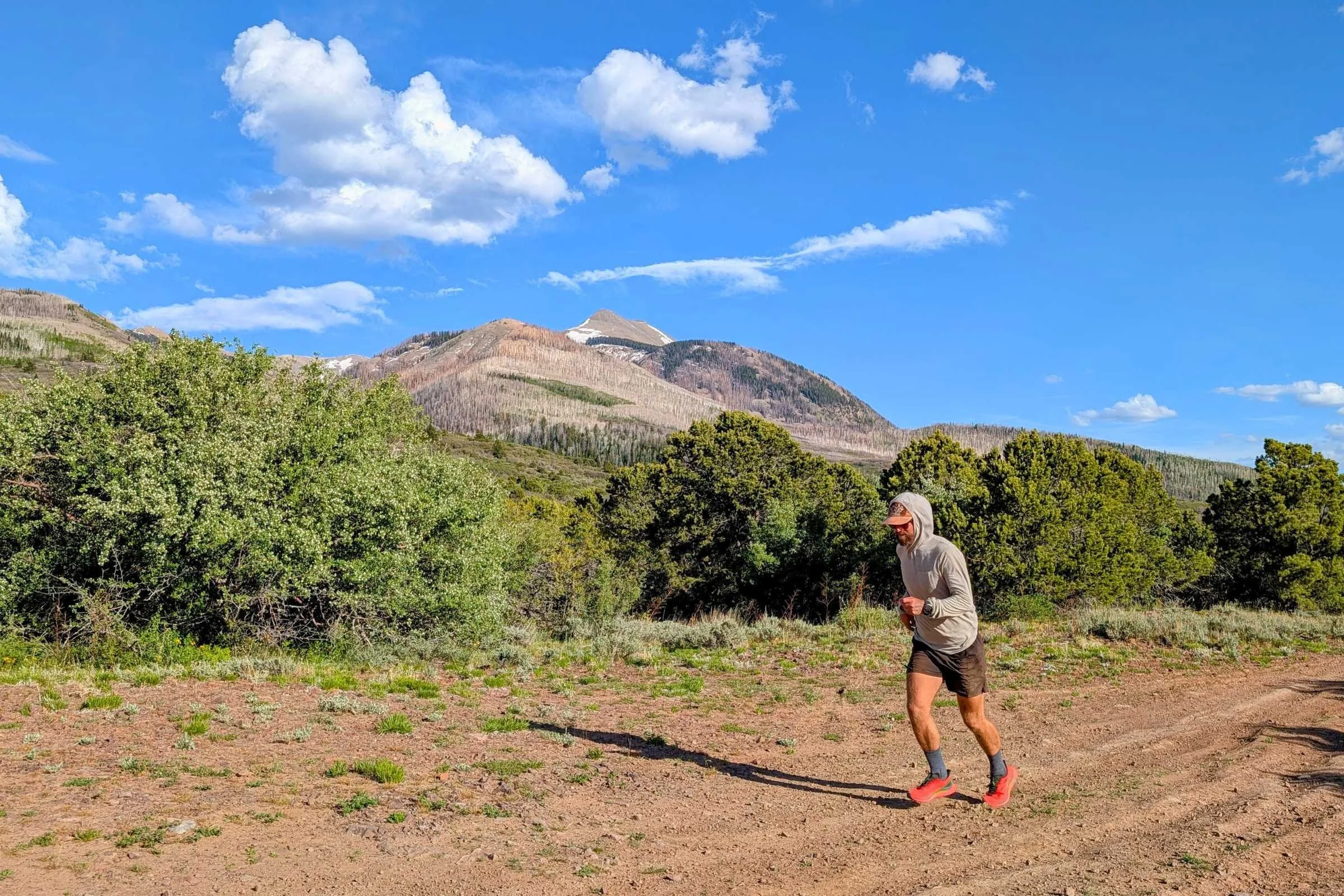
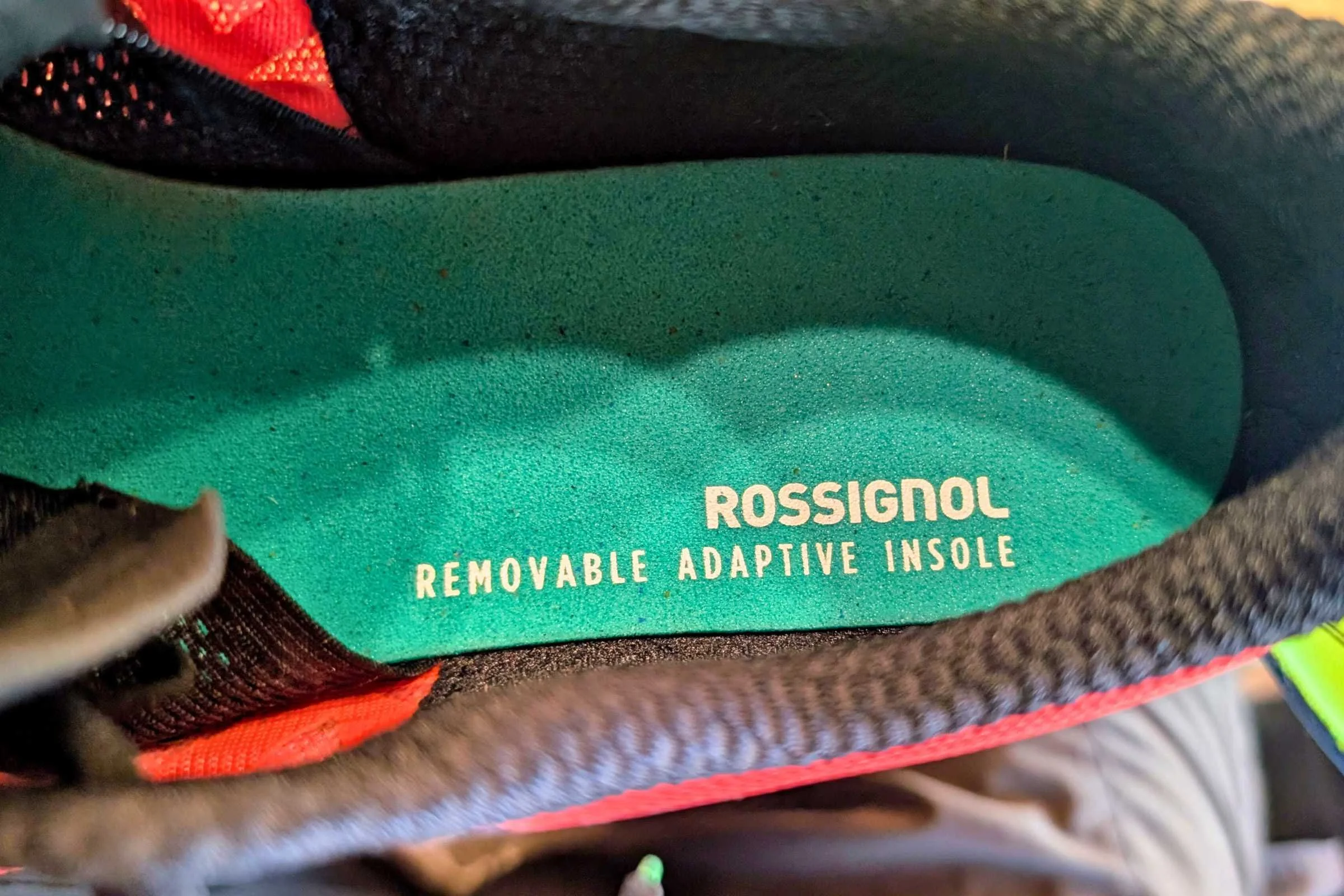
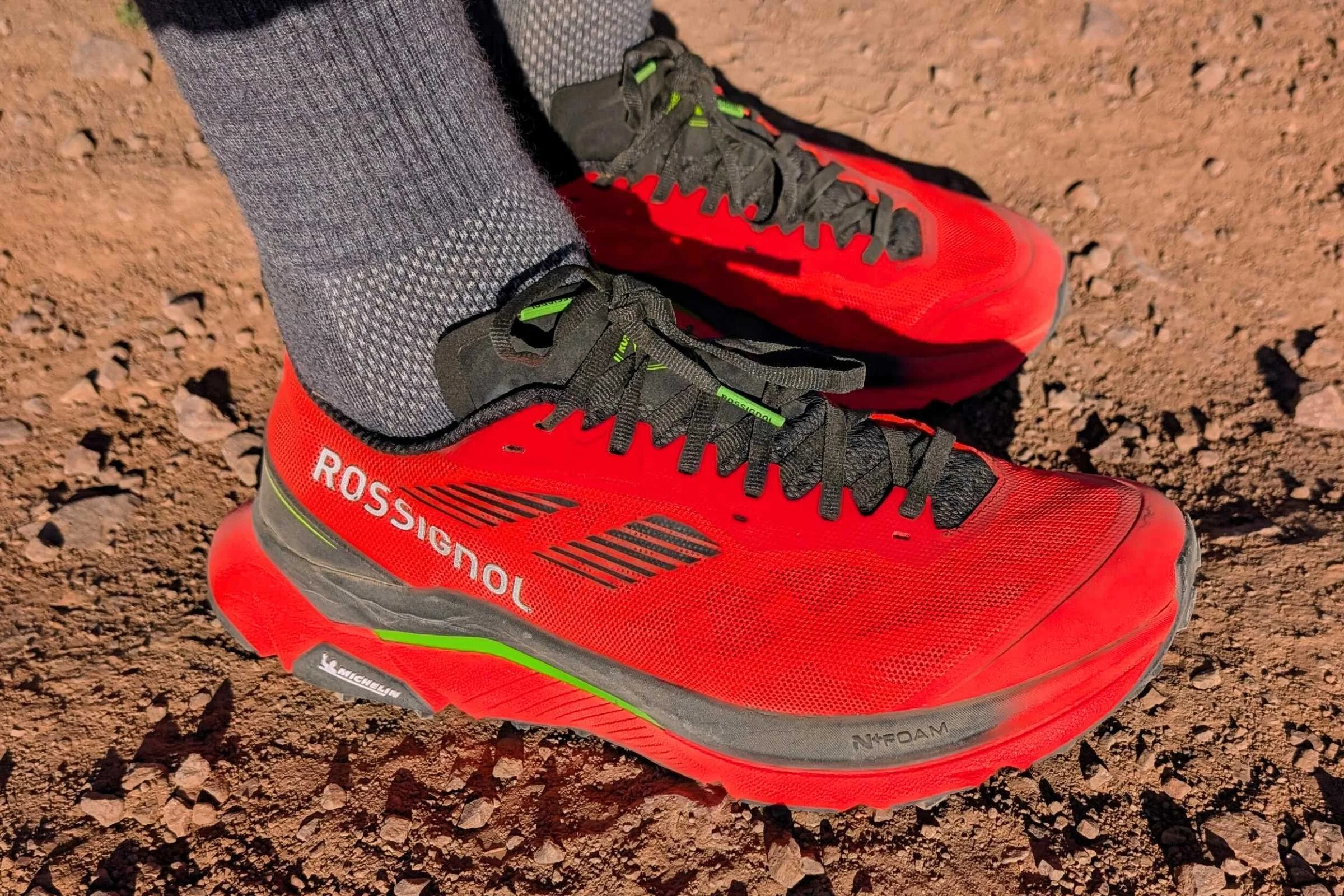
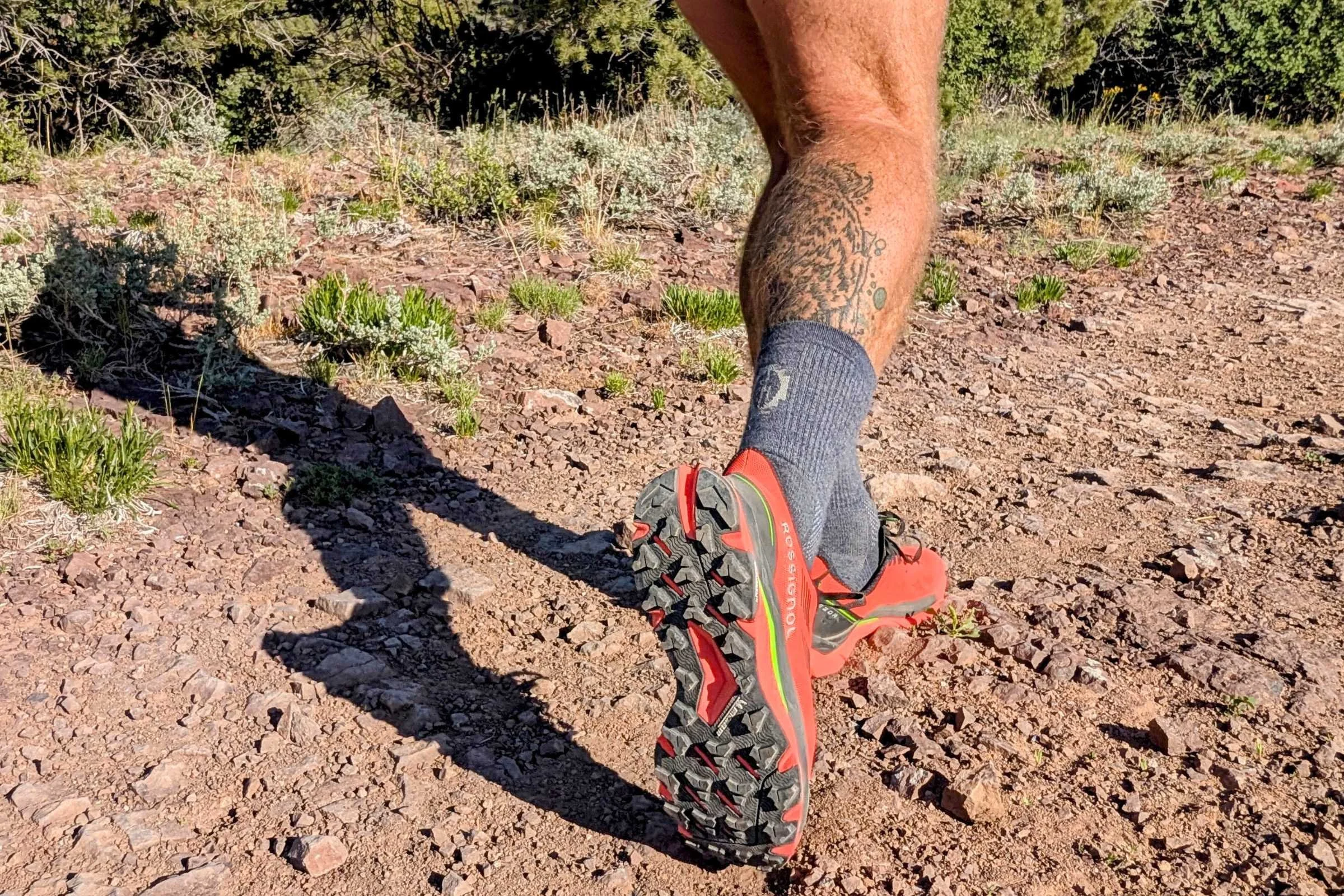
Sizes available: 39 - 49.5
Widths available: Standard
Drop: 6 mm
Stack height: 31 - 25 mm
Weight: 10.9 oz / 310 g
What we liked: cushion, excel on technical, supportive, stable, traction
What we didn’t like: price, sizing, narrow
The La Sportiva Akasha II is an all-around excellent trail running shoe, designed specifically for mountain running. We reach for these shoes often because they offer more cushion than many La Sportiva shoes, with the exception of the Prodigio and Prodigio Max, and are fantastic on technical terrain. They’re supportive, stable, and inspire confidence on rocky trails, granite scrambles, and steep slopes.
Although they excel on rugged terrain, they also perform very well on smoother trails. We’ve worn these for countless 20–50 mile days, and know several runners who use these shoes for 100–250 mile races.
They have short, low-profile lugs and a sticky rubber outsole. Along the edges of the outsole, on the inside area near the toe and the outside of the heel (referred to as the “climbing zone” on approach shoes), there is smoother and more durable rubber. This allows you to smear on rock faces more easily while increasing the longevity of the outsole rubber.
La Sportiva Akasha II
It has a dual-injection EVA midsole that reduces shock as you run over rocky, rugged terrain. And the midsole is shaped with a trail rocker, which encourages your foot to roll forward with each stride. These shoes feel firm underfoot, yet remain comfortable for extended days on the mountain.
The biggest drawback with these shoes, like every pair of La Sportiva shoes, is the sizing. We get a full size larger than we usually wear in other brands with the Akasha II. Even after getting a full size larger, these shoes are slightly narrower in the toe box than we’d ideally want. The fit is excellent, and you can’t have a shoe that allows your toes to splay out and climb technical terrain like a rock shoe, but they’re just not wide enough for our slightly wider-than-average feet for extremely long days. If you have narrower feet, don’t sleep on these shoes, though.
Sizes available: 40 - 48
Widths available: Standard
Drop: 4 mm
Stack height: 28 - 24 mm
Weight: 10.2 oz / 290 g
What we liked: supercritcal foam adds momentum
What we didn’t like: stiff midsole, price
The Scarpa Spin Ultra 2 is a trail running shoe designed for long distances over moderately technical terrain. We found they worked best on hard-packed dirt. They have 28 mm of stack in the heel and 24mm in the forefoot. They have a Vibram Megagrip outsole and 2.5mm lugs.
While the Spin Ultra 2 is billed as an all-day comfort trail running shoe, we found the midsole to be pretty stiff. This supercritical foam midsole helps maintain momentum as you push off, but it isn’t as comfortable as shoes with a more flexible midsole. As you break them in, the midsole isn’t quite as stiff, but they’re certainly still firmer than average.
The Spin Ultra 2 are some of the most expensive trail running shoes we tested, and don’t perform as well as we’d hope for a shoe that costs just under $200.
Scarpa Spin Ultra 2
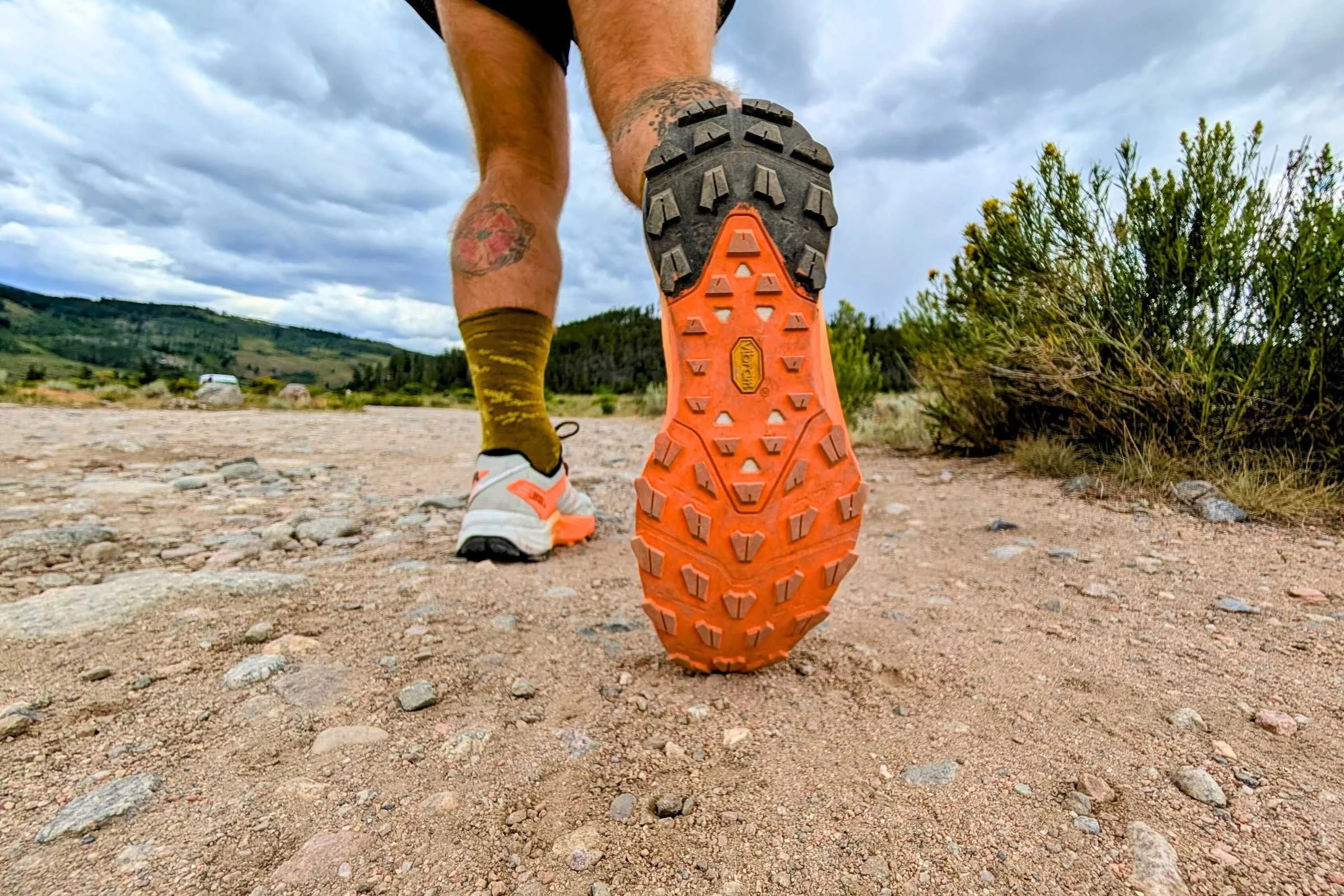
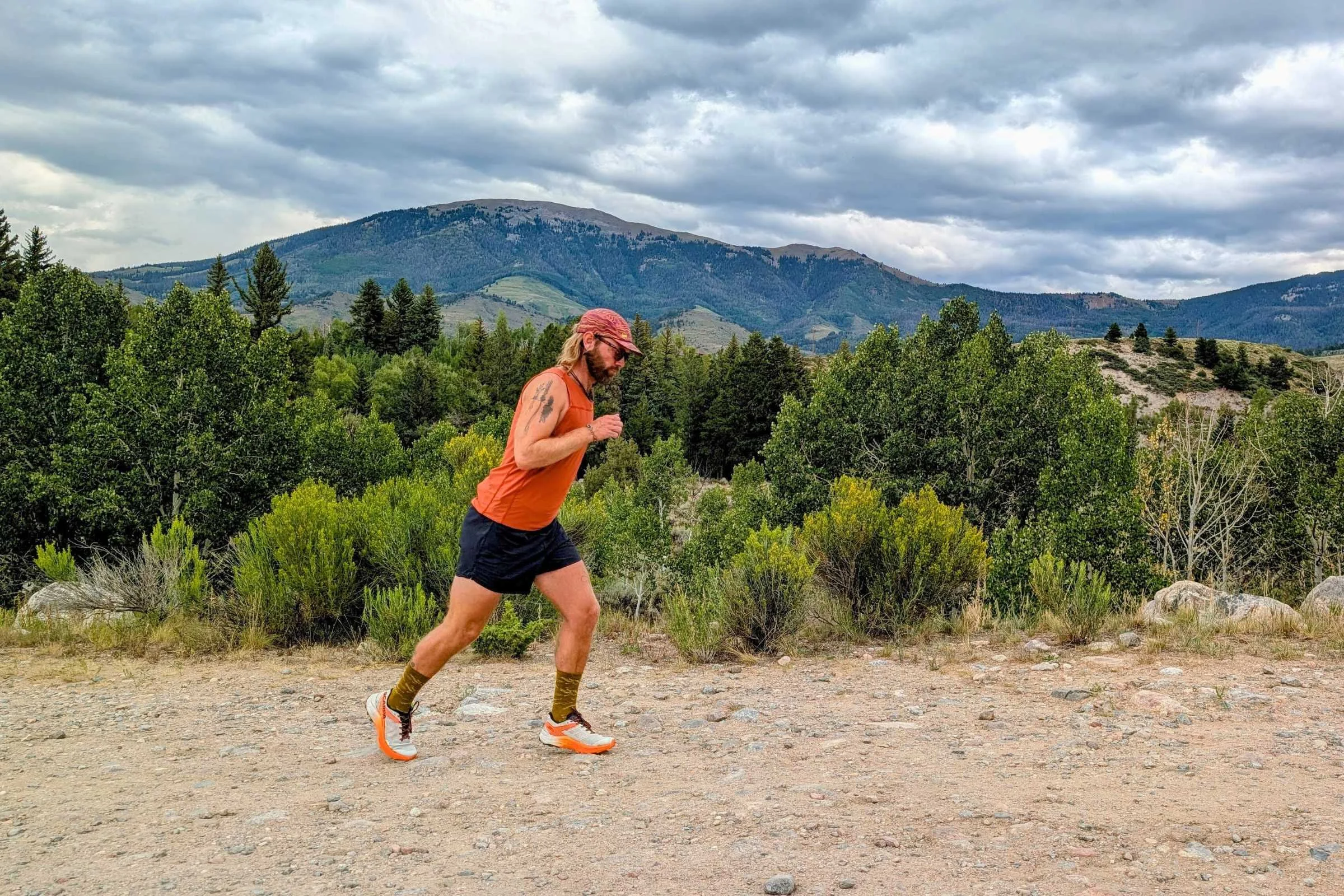

Sizes available: 7 - 14
Widths available: Standard
Drop: 8 mm
Stack height: 36.8 - 44.8 mm
Weight: 11.7 oz / 332 g
What we liked: grippiness, surprisingly stable, good for uphill
What we didn’t like: less stable on downhill, price, versatility
The HOKA Mafate 5 are trail runners designed for technical trails where you need maximum grip. They take everything trail runners loved about the Mafate 4 and improve on them.
The most notable difference is that the Mafate 5 features a ton of stack: 45 mm in the heel and 37 mm in the forefoot. Considering the fact that your heel is a full 50 mm off the ground (including the 5mm lugs), the Mafate 5 feels surprisingly stable. We wore these on trail runs in Colorado’s Sangre De Cristo mountains, on wet, steep, technical trails. The deep lugs and Vibram Megagrip outsole bite into loose dirt really well, and inspire confidence on downhill sections of trail.
HOKA Mafate 5
The midsole uses a dual-density foam design, with a supercritical foam layer throughout the heel and on the top side (closest to your foot) of the forefoot. There is also compression-molded EVA foam along the bottom of the forefoot (closer to the ground). This compression-molded foam is lighter and helps with stability, while the supercritical foam is springier. There is also a TPU plastic plate, which HOKA calls its Rocker Integrity Technology, sandwiched between the two foam layers in the forefoot to add stiffness. This isn’t a carbon plate, and it doesn’t go the full length of the midsole, but it makes the shoe feel more solid when you push off.
We mentioned the massive amount of stack height above, but we want to return to this. The 45-37 mm of stack means they have 8 mm of heel-to-toe drop, which is a lot for a trail shoe. This makes them well-equipped for running uphill, but a little less stable on downhill sections. The high stack and TPU plate certainly make these shoes feel fast.
We think the new HOKA Mafate 5 is a great shoe for those looking for an ultra-cushioned shoe for high-mileage days, but we’re not convinced they’re as versatile as some other trail running shoes with less heel-to-toe drop and a slightly lower stack height. They’re also more expensive than our favorite HOKA trail shoes, the Speedgoat. Learn more in our in-depth review of the HOKA Mafate 5 trail running shoes.
How to Choose a Trail Running Shoe
What terrain will you be running in?
Different trail running shoes excel on different types of terrain. Depending on what kind of trails you like to run, you’ll want to pick a shoe optimized for that terrain. Some trail running shoes are better for steep uphills and descents, while others are better for smoother and flatter trails.
Shoes with a grippy sole, bigger lugs, and more heel-to-toe drop will often be better for going uphill, and the grippy soles and deeper lugs will help with traction on downhill sections as well. Deeper lugs are especially helpful in wet, muddy conditions. Burly lugs won't be as beneficial on that terrain if you usually run in dry, hard packed, and loose dirt. Trail runners intended for rockier, less stable trails usually have a more substantial toe cap to protect your foot from sliding rocks. They also have a rock plate or some other underfoot protection, so you don’t hurt your feet running over rocky terrain.
In our experience, while all these things are important for trail running on rougher terrain, they’re not as important as fit. When the ground is unstable beneath you, the last thing you want is your heel sliding inside your shoe. So for uneven terrain, having a locked-in heel is critical. Shoes with less heel-to-toe drop, shorter lugs, and less underfoot protection are better for smoother, less rugged trail. If the trails you primarily run on are well-maintained, not very rocky, and often dry, then you don’t need a shoe designed to handle the rougher trails. Shoes designed for smoother trails will be lighter since they don’t have all the extras that make trail running over rugged terrain possible.
We usually have a few pairs of trail running shoes to choose from and select the best pair for the terrain we plan to run that day. If you’re buying your first pair of trail runners, we recommend getting one of the many shoes we reviewed here because most are great all-around trail running shoes.
The Topo Athletic are great for trail and rough trail but aren’t designed for off-trail or scrambling.
Will you be running in the rain?
If you run in the rain often, you might want to get a pair of waterproof trail running shoes. Many of the shoes we tested here come as waterproof trail shoes, but not all do. However, if you’re not running in cold, rainy conditions, you don’t necessarily need to get waterproof trail running shoes. We’ve run 1000s of miles in the rain and only use waterproof trail running shoes when it’s cold and rainy. Waterproof trail runners are a good idea in cold, snowy, or slushy conditions. But for rainy runs or warmer weather, those waterproof trail runners aren’t going to help that much.
If you’re running in the rain, your feet will likely get wet, even if you wear waterproof shoes. And with waterproof trail runners, any water that gets in through the top of the shoes will become a puddle around your foot. So unless you’re wearing waterproof gaiters and pants to keep the water out of your shoes, those waterproof trail shoes aren’t going to help you that much. On the other hand, the mesh on standard trail running shoes allows water out of your shoes as well as into them.
If you’re running in the rain, the best running shoe for you is something with a sticky rubber outsole. This recommendation is especially true when running over slick rock or other exposed slab. You want that outsole to be as sticky as possible when running in the rain. If you’re running in the rain over dirt, that dirt will be mud. In wet, muddy, rainy conditions, the best shoe is something with deep lugs to grip the earth beneath you as much as possible. The outsole may almost resemble what you'd find on a hiking boot design, but with much lighter weight materials.
For more tips, see our guide to Tips for Running in the Rain and What to Wear Running in the Rain.
Comparison of the soles on some of the trail runners we tested. From left to right: La Sportiva Jackal II, La Sportiva Wildcat, Altra Lone Peak 7, Salomon Speedcross 5, and La Sportiva Cyklon Cross GTX.
Are you looking for a trail running shoe for hiking or backpacking?
We almost exclusively wear trail running shoes for hiking and backpacking. To be honest, a lot of what’s considered trail running is actually just fast hiking. We've also hiked in most of the trail running shoes we tested here.
Some trail runners make better hiking and backpacking shoes than others, though. For backpacking footwear, look for a trail runner with good durability. Some trail runners aren’t intended to be worn with a 25+ pound pack, and they might not last as long because of this. Features like a thick rubber toe cap and a dense midsole mean they’ll last longer as backpacking and hiking shoes.
For more on this topic, see our guide to Trail Running Shoes vs. Hiking Shoes.
The author in the Salomon Sense Rides on a backpacking trip. When choosing what trail runners to wear, decide your use case scenario, where you’ll be running, and the conditions you expect.
Will you be running on pavement and trails on the same run?
Some of us don’t live right next to a trail. Most of us aren’t that lucky. Many trail running shoes are designed for running on pavement and dirt. Many trail runners can be used on pavement, but some are better suited for pavement.
The best trail running shoes for a mix of pavement and dirt, or crossover shoes as we call them, will have less pronounced lugs that won’t wear down on the pavement but still give you enough traction on trails. They also have a more protective midsole, so they won’t feel as light and nimble as a road running shoe, but they’ll be better on uneven terrain.
Crossover trail runners aren’t the shoes we’d recommend for technical trails that require a lot of traction, but they’ll do well on hard-packed dirt, gravel, and recreational paths. Really, any shoe you’re wearing on a trail is a trail running shoe, but crossover shoes are much better than road running shoes on the trails, and they’re good on pavement, too.
For more on this, see our in-depth to the Hoka Challenger 7, our winner for best crossover shoe.
Do you like a minimal trail shoe or a shoe with max cushioning?
Everyone has personal preferencing regarding trail running shoes. Depending on your preferences, you might like a more minimalist shoe with less cushion that allows you to feel the trail underneath you. Or, you might prefer a more cushioned trail running shoe because it reduces foot fatigue over a long day on the trail. Neither preference is wrong, but they do require a different shoe.
A cactus that lodged itself into a pair of Hoka trail running shoes we were testing. The stack height and cushioning is enough that even the spines on this plant didn’t penetrate through.
Do you have special sizing needs, such as wide feet or pronation?
Some trail running shoes come in wide sizing. For men, wide sizing is often called “2E” sizing. Some trail runners, such as the Hoka Speedgoat and Challenger, come in wide (2E) and standard-width (D) sizes.
Some trail runners are simply wider than others. Shoes designed for long distances, such as the La Sportiva Wildcats and Altra Lone Peaks, have a wider toe-box to allow your forefoot to spread out over the course of a long day. Depending on the application, we’ve worn both wide sizes and standard-width-sized trail runners.
If you have other sizing needs, such as pronation, we recommend you try several trail running shoes to see which provide the best arch support for your feet to prevent overpronation. Trail runners with more arch support may help, but everyone’s feet are different.
We’ve also successfully put Superfeet Hike Support insoles in our trail running shoes to help with arch support. You can also get custom insoles made for your feet, and Superfeet has a program to do this. We’re currently testing a pair of these, and they feel great so far.
Read more about the benefits of wearing insoles with your trail running shoes here.
Should I use trail running shoes or hiking shoes?
Whether you use trail runners or hiking shoes depends on the trail, how much ankle support you need, whether you're carrying a pack, and many other features. We break it down in our article trail running shoes vs. hiking shoes.
Trail Running Shoe Anatomy
Talking about trail running shoes can get technical, but they’re just shoes, really. We’ll define some key parts of a trail running shoe below.
Midsole
This is the part of a trail running shoe that contains the cushioning. The midsole is a cushioning foam that sits above the outsole, in between the insole and outsole of a shoe.
Outsole
The outsole of a trail running shoe is the part of the shoe that makes contact with the ground. The outsole of a trail running shoe is made of durable rubber that will grip the trail as you move.
Insole
The insole is a removable insert that sits between the bottom of your foot and the top of a shoe’s midsole. We go into more detail about this below, but you can replace the insoles in your trail running shoes to get more arch support.
Upper
The upper of a trail running shoe is all the material that makes up the shoe. Trail running shoe uppers are attached to the midsole, and are usually made of mesh or other breathable material. The upper is where the shoelaces attach to trail running shoes.
Toe box
The toe box of a trail running shoe is the area where the front section of your foot sits. Toe box is used to reference the shape of the shoe beyond where the laces reach. The amount of space in the toe box varies widely among trail shoes.
Tongue
This is the part of the upper that sits between the laces and the top of your foot. The tongue is usually only attached to the upper near the bottom of the laces, at the toe box. Some trail running shoes have a tongue that wraps around the entire top of your foot for a more secure fit.
Heel Cup or Heel
The heel cup of a trail running shoe is the place where your heel sits inside the shoe. This is sometimes also referred to as the heel counter. Really, this is the back of the shoe that is responsible for holding your heel in place.
Last
The last is a foot-shaped mold that a shoe is molded around. The shape and size of the last determines the shape of a shoe. When talking shoes, last is used as shorthand for the overall shape of the shoe
The author running in the winter in the La Sportiva Jackal II trail running shoes, which have excellent grip even on snow.
Buying Advice
There are hundreds of trail running shoes, so finding the right one can be difficult and overwhelming. We’re here to help. We’ll tell you what to look for in a trail running shoe. We’ll tell you what may not be as crucial for your first trail runner, and we’ll tell you what is.
We’ll break down what makes a great trail running shoe. That way, you can make your own informed decision on which trail running shoe is best for you.
We wrote a separate article about how to choose trail running shoes, but we’ll go through the most important points below to help you choose the best trail runners here as well.
Stability
Trail running shoes should feel stable because you’re running over varied terrain. You don’t want your foot to move inside a shoe when pushing off a giant root, do you? For this reason, you want a shoe that inspires confidence in your feet, providing a platform to move quickly over unstable terrain.
Many factors come into play when assessing the stability of a trail running shoe. A trail running shoe with good stability mostly fits well and has good traction.
Side note: In the (road) running shoe world, “stability” is also a category. Running shoes are sometimes categorized as either “neutral,” “stability,” or “cushioned.” In this sense, “stability” refers to the amount of arch support a shoe provides to prevent overpronation. Read the “Arch Support” section below for more on this.
Traction
The La Sportiva Wildcat trail running shoes have a unique lug pattern made of long, thin rubber cleats that run lengthwise across the bottom of the shoe.
Trail running shoes have a grippy tread on the underside to maintain traction over loose, muddy, or snowy conditions. This tread is found on the shoe’s outsole, or the part that contacts the ground. The tread is made of a pattern or lugs, rubber cleats that dig into the ground to give the shoe traction.
The lugs on trail runners vary in size. The size of the lugs of trail runners is referred to as “lug depth” since it measures how deep the lugs can dig into the ground. The lugs on a trail running shoe can be big and few, small and many, or a combination of both. Lugs come in many different shapes and sizes. Generally speaking, the more pronounced the lugs and tread on a running shoe, the more they will grip the ground under you.
Another factor contributing to traction is the rubber compound used in the outsole to make up the tread. Not all rubber is equal. If you walk across an angled rock surface in climbing shoes, the road running shoes, you’ll notice a difference in how well the shoes grip the slick rock. For this reason, trail running shoes tend to use stickier rubber than road running shoes. But, some trail runners use a grippier rubber compound than others.
WeighT
How much does this trail runner weigh? This one is simple and easy to measure with a scale. Weight is essential in trail runners because you’ll use your legs to lift each shoe 1000s of times every run.
Stack Height
Measuring stack height of two trail shoes. Here are two extremes: Hoka Challenger 7 (left) and Altra Lone Peak 7 (right).
Stack height refers to the total height of everything between the bottom of your foot and the ground in a trail running shoe. Stack height comprises the outsole, where the tread is found, and the midsole, where the cushion and supportive parts of the shoe are found. Stack height is often measured in two numbers, one under the heel and one under the forefoot, since most trail running shoes have a different measurement in these places (see heel-to-toe drop below).
Waterproofing
Some trail running shoes are waterproof, but not all are. Waterproof trail runners are usually made with a waterproof material in the upper instead of mesh. Waterproof trail runners don’t breathe as well, which can cause blisters in warm conditions. For this reason, we think waterproof trail running shoes are great for cold and wet conditions, but not when it’s warm out.
We wear waterproof trail running shoes in winter, mostly for running through the snow. But we usually put our waterproof trail runners away in the spring and reach for a breathable mesh pair instead.
Mesh and Breathability
Mesh and breathability are important for a trail running shoe. When running or hiking for hours, a shoe with lots of mesh to allow your foot to breathe keeps your feet drier and helps prevent blisters. Wet feet can slide inside the shoe and cause stability issues and blisters. Except for in cold weather, we recommend trail running shoes with a breathable mesh upper in all conditions.
Comfort
A comfortable trail running shoe can be the difference between having a great day on the trail and having sore feet. We recommend trying on as many styles of trail running shoes as you can to see which feels the most comfortable to you. Everyone’s feet are different, and something that fits your feet well will be the most comfortable.
Other factors play into the comfort of a trail runner: underfoot cushioning, tongue design, and even the thickness of the laces can affect the comfort of a shoe. Exposed seams can chafe or rub over the course of a long run, too. We assessed all these trail running shoes for long-term comfort during testing, but you can feel a lot of these comfort factors when you first try on a shoe. Try on some trail running shoes and see for yourself.
While the wide platform on these shoes makes for a very comfortable ride, some don’t love how it makes them feel less stable.
Protection
Most trail running shoes have some protection in the upper for rocks, roots, and debris on the trail. This protection is most evident in a rubber protective toe cap on trail runners. Some trail running shoes have a big, burly, rubberized toe section that wraps onto the top of the shoe. Some trail runners have less toe protection. You’ll also see more substantial protection along the sides and heel of trail runners than you do on road running shoes.
Depending on the type of trail you’ll be running most often, pick a shoe with more or less protection. If you’re always going to be running on well-groomed trails, you don’t need as much protection as you will if you’re primarily running on a rugged trail or off-trail scrambling missions.
Trail feel
Trail feel refers to how much your feet can feel the trail through the underside of a shoe. Generally speaking, the lower the stack height, the better you’ll be able to feel the trail. Trail feel is important for maintaining stability over varied terrain, but too much trail feel could make your feet feel sore after a long day running over sharp rocks or roots.
Rock plates
Some trail running shoes have rock plates to protect the soles of your feet from feeling the sharp edges of rocks on the trail. But, you guessed it, a rock plate also diminishes how well you can feel the trail beneath you. Some trail running shoes come with a removable rock plate, which is a stiff insert between the insole and midsole of a shoe. That used to be more popular with trail runners, but these days rock plates tend to be built into the midsole of trail runners.
Heel-to-toe drop
Heel-to-toe drop refers to the difference in stack height between the heel and forefoot of a shoe. It is, quite literally, the number of millimeters the shoe drops from the heel to the midsole.
More heel-to-toe drop makes you naturally lean forward and helps propel you up a hill. But, too much heel-to-toe drop can make you feel unstable, so finding the right balance of forward lean and stability is key here. The “best” heel-to-toe drop usually comes down to personal preference, but we recommend starting with a trail runner with an average (4-8 millimeters) drop.
Some trail running shoes are “zero drop.” These shoes have no heel-to-toe drop and allow your foot to move in the same ways it would if you were barefoot. Some people love zero-drop shoes.
Some people prefer some amount of drop. There is no wrong answer here.
Heel slippage
The heel cup of a trail running shoe should fit your foot well to minimize heel slippage. Here are three heels to give you an idea of how they are shaped differently. From left to right: Salomon Sense Ride 5, Hoka Speedgoat 5, Brooks Catamount.
Heel slippage will negatively affect the comfort and stability of a trail running shoe. If your heel doesn’t fit into a shoe properly, it will slide slightly every time you push off the ground. This sliding can cause chafing and blisters on the back of your heel.
When trying on trail running shoes for the first time, be sure to wear the socks you’d normally wear when running. Then, find an inclined surface to push up on to determine whether the heel slips on this particular model.
If you like how a shoe feels, but the heel slips, you can also try the runner’s loop lacing method. This technique is a lacing alternative that locks your heel in place.
Cushioning
Close-up on the Saucony Peregrine and its comfortable upper and generous cushioning.
A trail running shoe with adequate cushioning will keep your feet comfortable and happy over a long day on the trail. You can usually tell how much cushioning a trail runner has by looking at the shoe's stack height. However, more cushion is not always better.
A trail running shoe with a lot of cushioning will affect trail feel and stability. If you’re higher off the ground, your foot can more easily roll and could cause an ankle sprain. When choosing your shoe, remember that trail running shoes usually lack the ankle support of a hiking boot. Not enough cushioning will tire your feet, though. The right amount of cushion will vary based on the runner and the conditions.
Arch support
Most trail running shoes have a stiffer midsole and, therefore, more arch support than a road running shoe. But, some trail running shoes are more “stable” in this sense than others. Generally speaking, a more minimalist trail running shoe will have less arch support than a shoe with a sturdier midsole.
FAQ
Close up of the La Sportiva Jackal II on rocky terrain.
-
You can use trail running shoes on the road. Trail running shoes are running shoes, after all. But, you will wear down the tread designed to provide traction on dirt if you run with trail running shoes on the road for long distances. Some trail running shoes are designed for a mix of roads and dirt, so we recommend this style if you plan to run on multiple surfaces with your trail running shoes.
-
Trail running can be better for your feet because running on an uneven surface makes the small muscles in your feet actually work. On smooth surfaces, only the large foot and ankle muscles are activated. But your feet must conform on trails and maintain balance on varied terrain.
-
The difference between running shoes and trail running shoes is that trail running shoes have an underfoot tread designed for dirt, rocks, and roots. Trail running shoes also have more material to protect your feet as you move over and around any obstacles.
-
Trail runners should be relatively tight so your foot doesn’t slide around in the shoe as you push off in any direction. However, trail running shoes should not be so tight that they constrict blood flow to your feet or make them uncomfortable.
Depending on the terrain, you should tighten your trail running shoes enough to maintain stability while being as comfortable as possible. -
Trail shoes should not always be a size bigger, but sometimes this is a good idea. If you’re going to be in a hot environment or running for long distances where your foot will swell, you might want to try a trail running shoe a half or full size bigger. This factor varies from person to person, though. Many trail running shoes designed for ultra-distances have a bigger toe box, which is usually where your foot swells. In this case, you might not need a larger trail shoe.
-
You can absolutely run long distances in trail running shoes. Trail shoes are designed to be used for long-distance runs.
-
You should wear comfortable running socks that breathe well with trail running shoes. Some prefer wool socks for trail running, while others prefer synthetic socks. See our guides to the Best Running socks for more recommendations. You may prefer hiking socks if you're hiking, backpacking, or thru-hiking. See our guide to Best Hiking Socks for our favorites.
You can also learn about our favorite running gear items in our Best Running Accessories guide.
The author testing the ON Cloudvista shoes on technical terrain.
How we tested
The author running in the Salomon Sense Ride trail shoes, a comfortable cushioned trail runner at a more affordable price.
We tested trail running shoes over several months on trail runs in Colorado and Arizona. We wore every pair on the Colorado Front Range trails we know best and explored new trails to see how they fared in less predictable conditions. We ran anywhere from 25 to 50 miles per week while testing these shoes, and during the higher volume weeks, we could tell which shoes were more supportive than others. We wore many pairs back to back, on the same trail on the same day, to get a feel for how each pair did over the same conditions.
We've used some of the shoes we tested for several years and already knew them well, and some we wore for the first time during the testing process. We wore every pair for many runs throughout the testing process to determine how they break in and get a sense of their durability.
Our Testing Process
Rigorous trail running testing across diverse terrain and conditions
Testing Locations
- Colorado Front Range trail runs
- Arizona desert trail running
- New Mexico mountain running
- Utah technical trail terrain
- Back-to-back trail comparisons
- Various trail surfaces & conditions
What We Test
- Traction & outsole grip
- Cushioning & stack height
- Stability & heel fit
- Durability & protection
- Weight & trail feel
- Breathability & comfort
Close up on the sole and traction on the Hoka Speedgoat 5 trail running shoes.
Why do I need shoes that are specific to trail running?
Trail running presents a unique set of challenges compared to road running, and having shoes designed specifically for the trails can significantly enhance your performance and enjoyment. Here's why investing in trail running shoes is essential:
-
Trail running shoes feature rugged outsoles with aggressive tread patterns designed to provide optimal grip on uneven terrain, loose gravel, rocks, and muddy surfaces. This superior traction helps you maintain stability and confidence, reducing the risk of slips and falls.
-
Trails can be harsh on footwear, with rough terrain, sharp rocks, and debris posing constant threats to shoe integrity. Trail running shoes are constructed with durable materials and reinforced features such as toe guards and rock plates to withstand the rigors of off-road running, ensuring long-lasting performance and protection for your feet.
-
The uneven terrain encountered while trail running demands increased stability and support to prevent ankle twists and injuries. Trail running shoes often feature supportive midsoles with cushioning and arch support tailored to absorb impact and provide stability on varied surfaces, keeping your feet comfortable and protected mile after mile.
-
Trail running shoes offer additional protection compared to standard road running shoes, with features like reinforced toe caps, ankle collars, and protective overlays designed to shield your feet from sharp objects, roots, and other obstacles encountered on the trails. This added protection minimizes the risk of injury and allows you to tackle challenging terrain with confidence.
-
Many trail running shoes come equipped with waterproof or water-resistant membranes that keep your feet dry and comfortable when traversing wet or muddy trails. This feature is invaluable for maintaining foot health and preventing blisters and discomfort during inclement weather conditions.
-
Trail running shoes are engineered with the specific needs of trail runners in mind, incorporating design elements such as a lower heel-to-toe drop for a more natural stride on uneven terrain, reinforced uppers for added durability, and drainage ports to expel water and debris. These specialized design features optimize performance and comfort, allowing you to push your limits on the trails with confidence.
care and maintenance tips
The author running on rocky terrain in the Salomon Speedcross 6, which are trail running shoes noted for their traction.
-
After each run, remove any dirt, mud, or debris from your trail running shoes using a soft brush or cloth. Pay attention to the outsoles and crevices to prevent buildup that could affect traction and performance.
-
Allow your trail running shoes to air dry naturally after each use. Avoid placing them near direct heat sources like radiators or heaters, as excessive heat can damage the materials and compromise the shoe's integrity.
-
Take out the insoles of your trail running shoes regularly to allow them to air out and prevent odor-causing bacteria from accumulating. You can also wash the insoles separately if they become particularly dirty or smelly.
-
If your trail running shoes are especially dirty, gently hand wash them using a mild detergent and lukewarm water. Avoid using harsh chemicals or abrasive brushes that could damage the shoe's materials.
-
While some trail running shoes may be labeled as machine washable, it's generally recommended to hand wash them to preserve their quality and performance. Machine washing can cause the shoes to lose their shape or damage delicate components like cushioning and support structures.
-
When not in use, store your trail running shoes in a cool, dry place away from direct sunlight. Avoid leaving them in hot or humid environments, as this can cause the materials to degrade over time.
-
If you frequently engage in trail running or outdoor activities, consider rotating between multiple pairs of trail running shoes. This allows each pair to dry completely between uses and extends their lifespan.
-
Periodically inspect your trail running shoes for signs of wear and tear, including worn outsoles, frayed laces, or damaged seams. Address any issues promptly to prevent further damage and maintain optimal performance.
-
If your trail running shoes have waterproofing treatments, reapply them as needed to maintain water resistance. Follow the manufacturer's instructions for the specific product you're using.
-
Trail running shoes typically have a lifespan of 300 to 500 miles, depending on usage and terrain. Monitor the condition of your shoes and replace them when they show significant signs of wear to ensure continued comfort and support during your runs.
For more tips on gear maintenance and repair, see our entire section dedicated to cleaning, repair, and maintenance.
Why you should trust us / About the author
Sam Schild is a thru-hiker, trail runner, cyclist, and mountain athlete based in Colorado. He’s been a runner since he was a child when he ran 5 days a week as cardiovascular training for soccer. As he grew older, he stopped playing team sports and focused on running and cycling.
After moving to Colorado a decade ago, he started trail running on the local trails. Since then, he has completed countless ultra-distance self-supported trail runs on trails throughout the American Southwest. He has thru-hiked the Pacific Crest Trail, Continental Divide Trail, Grand Enchantment Trail, and the Colorado Trail twice, always in trail runners.
You can read more about Sam on his author page or his website.



















